The UEFA Under-19 European Championships kicked off in style with many young talents looking to make a name for themselves on the European stage; eight teams are taking part in this year’s competition, including the likes of Spain, Portugal and Italy.
However, defending champions England failed to qualify, setting the stage for another nation to take home the title this year.
Each team boasts a plethora of talent at their disposal, and as we know, this competition has witnessed the emergence of numerous young players on its stage.
For instance, in 2019, Gonçalo Ramos enjoyed an outstanding tournament for Portugal as they finished runners-up to a Spain side that included the now-Barcelona duo, Eric Garcia and Ferran Torres.
In this tactical analysis, which will take the form of a scout report, we will highlight some players to watch out for during this year’s tournament.
We will examine their roles within the team’s tactics, analyse their skill sets, and explain why you should keep an eye on them.
Cher Ndour Scouting Report – Italy U19
First up in this analysis piece is Benfica man Cher Ndour.
The 18-year-old is a central midfielder who primarily operates on the left side of a midfield three for both club and country; this provides him with the freedom to roam between the middle and attacking thirds, as we can see from the heatmap below (taken from all his games for Benfica B during the 2022/23 season).
By moving freely between the thirds, the young midfielder can often create numerical advantages in different areas of the pitch.
His fluid movement keeps the opposition guessing and makes it challenging for them to mark and track Ndour effectively.
Cher Ndour Heat Map
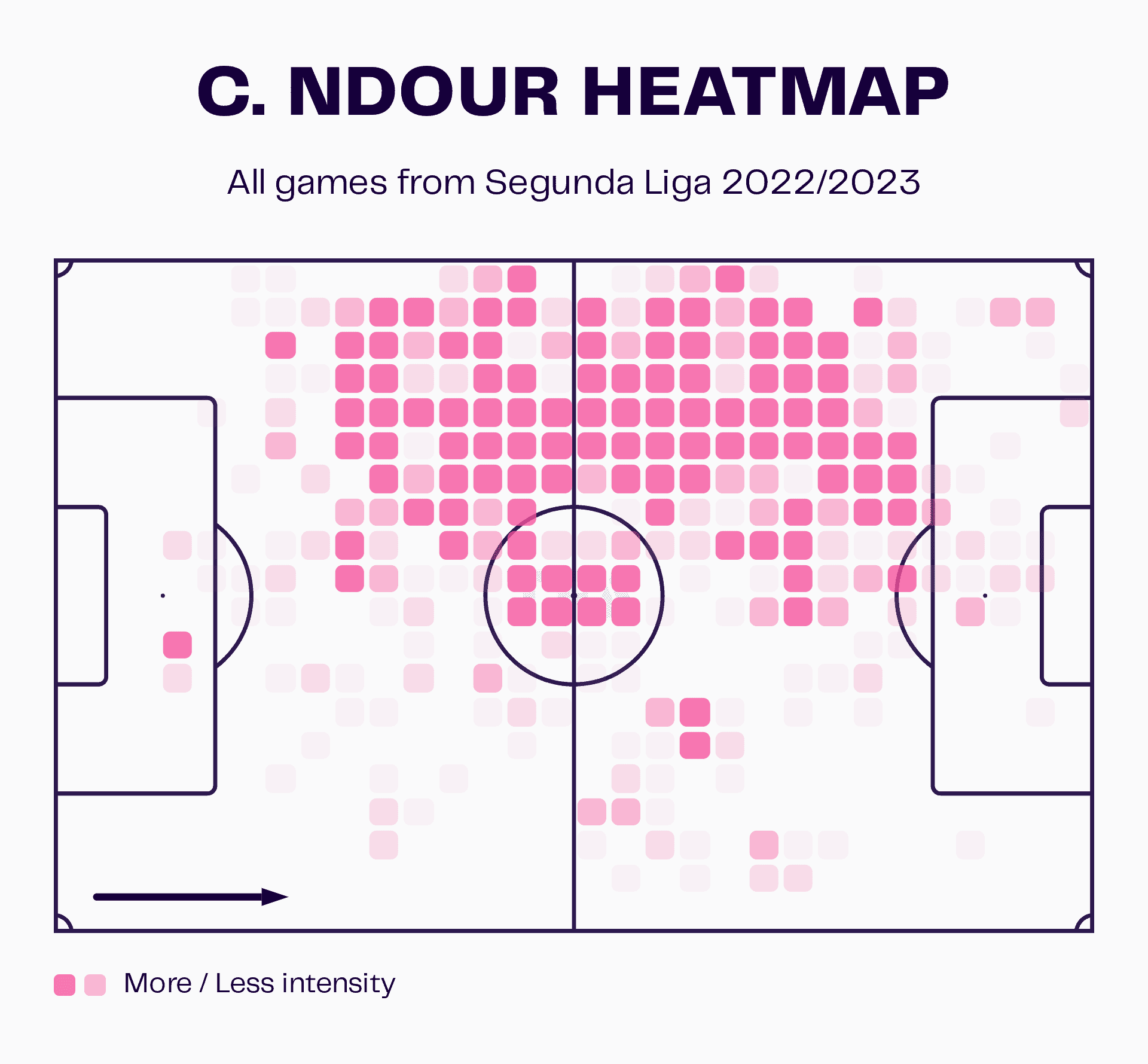
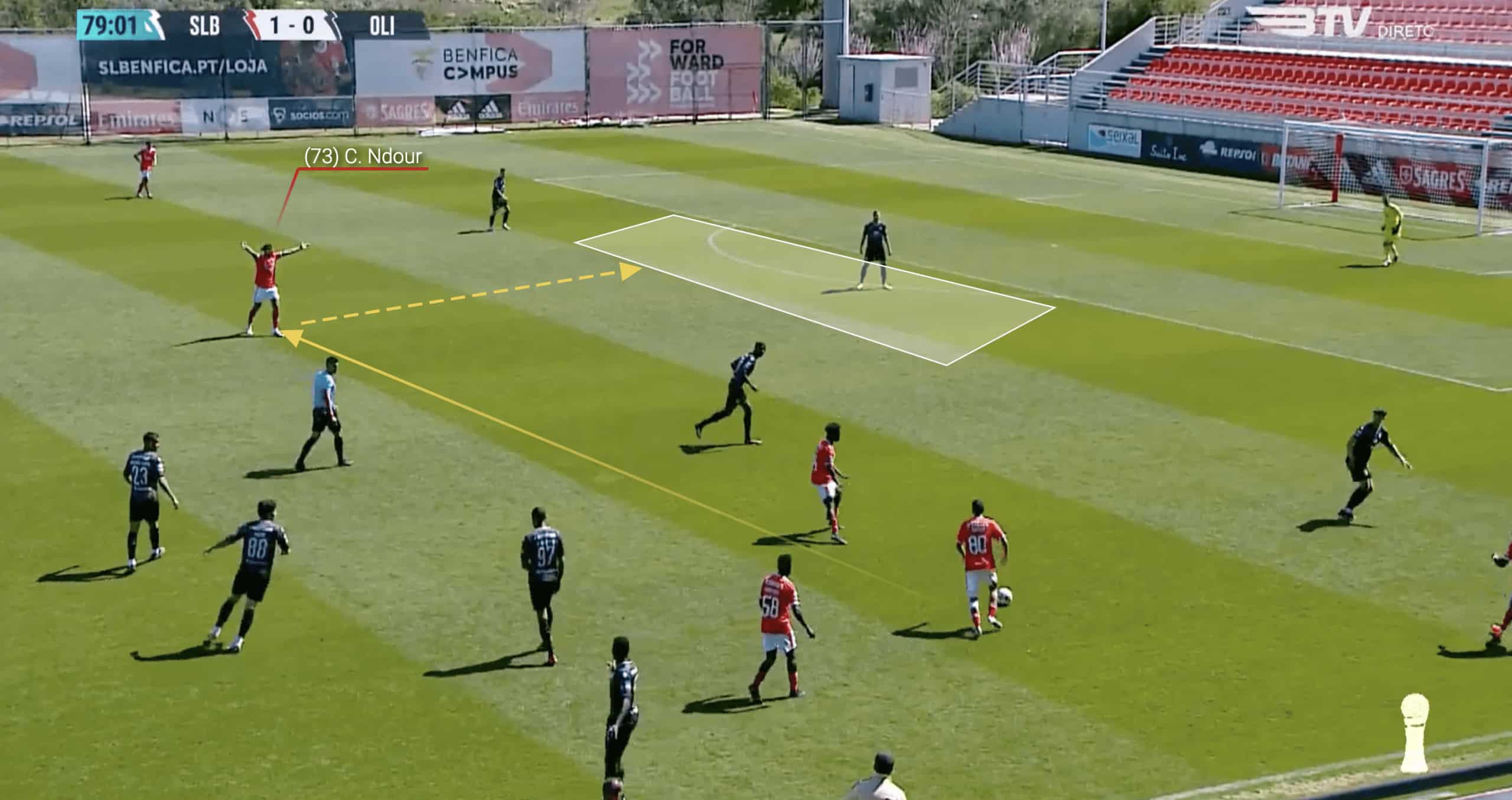
Although not necessarily a ball carrier, Ndour possesses a turn of pace and dribbling ability that enables him to drive into open spaces and advance the play when given the opportunity, complementing Benfica’s pass-oriented style of play.
Here in figure 1.1, for example, we can see Ndour demanding the ball from his teammate as he is in acres of space.
He receives the ball and immediately uses his pace as he runs into the open space; a couple of stepovers later, the Benfica midfielder unleashes a low drive which nestles in the bottom corner.
From Ndour’s heatmap, it is evident that he primarily operates outside the opposition penalty area.
On average, the youngster registered 1.19 touches in the penalty area per 90 minutes, indicating that he functions more as a link-up player than a prolific goal-provider.
This inference is supported by the fact that Ndour only managed to provide a single assist last season.
However, when he does venture into the penalty area, he demonstrates an ability to find suitable positions, as depicted above.
Instead of seeking out pockets of space surrounded by defenders, Ndour tends to exploit open spaces to make his runs.
Cher Ndour Progressive Passes Map
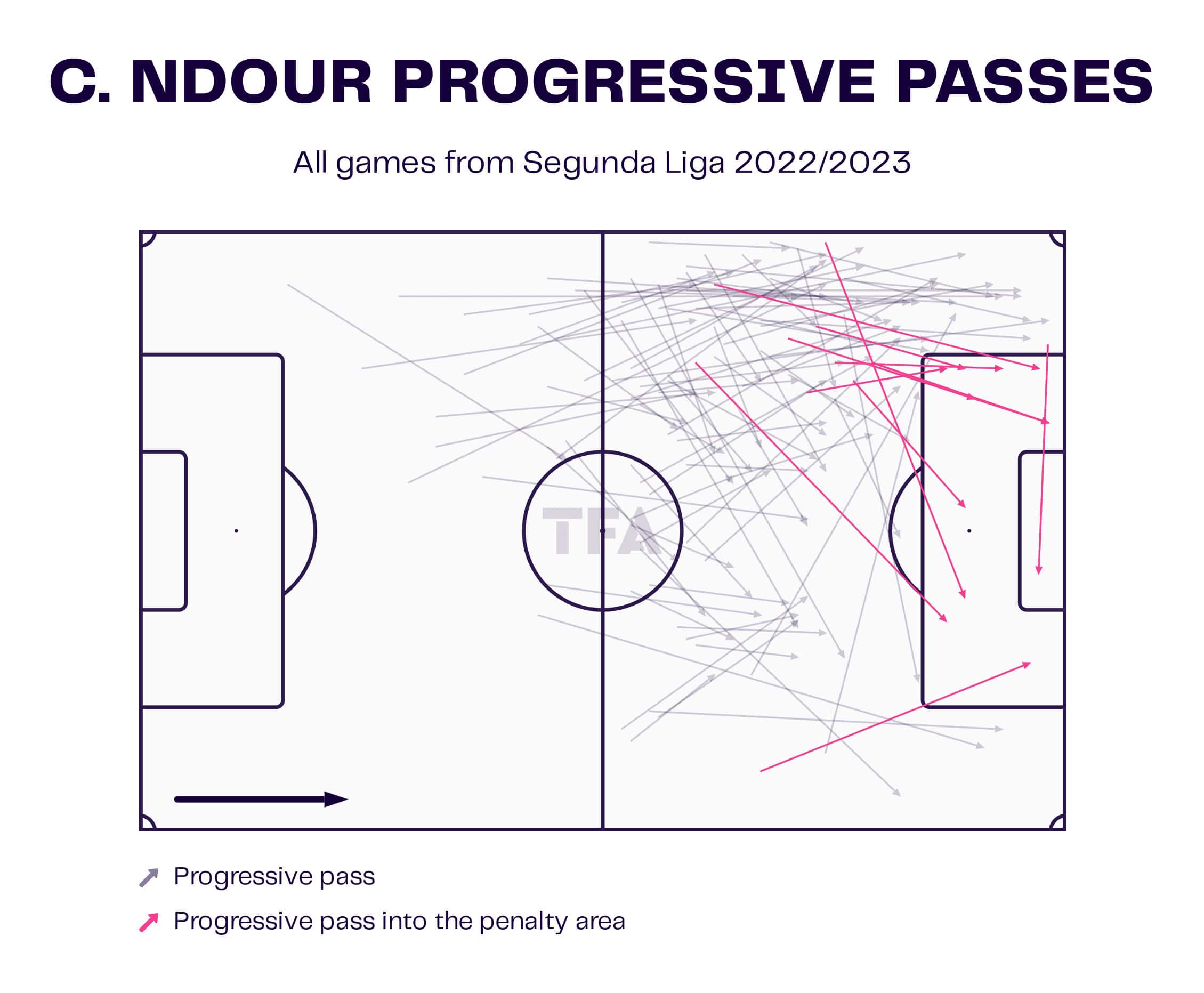
Moreover, from the data visual above, we can see that the majority of Ndour’s progressive passes were from the midfield and defensive third into the attacking third, the Italy U19 international averages 5.32 passes into the final third per 90, and not many of his progressive passes were into the opposition penalty area.
He can contribute to his team, maintaining possession and controlling the tempo of the game.
Ndour’s positioning outside the penalty area allows him to provide passing options for teammates in deeper areas and to link up with the attackers ahead of him.
He is able to receive the ball, distribute it efficiently, and facilitate the team’s ball circulation, which can help to wear down the opposition and create openings for attacking opportunities.
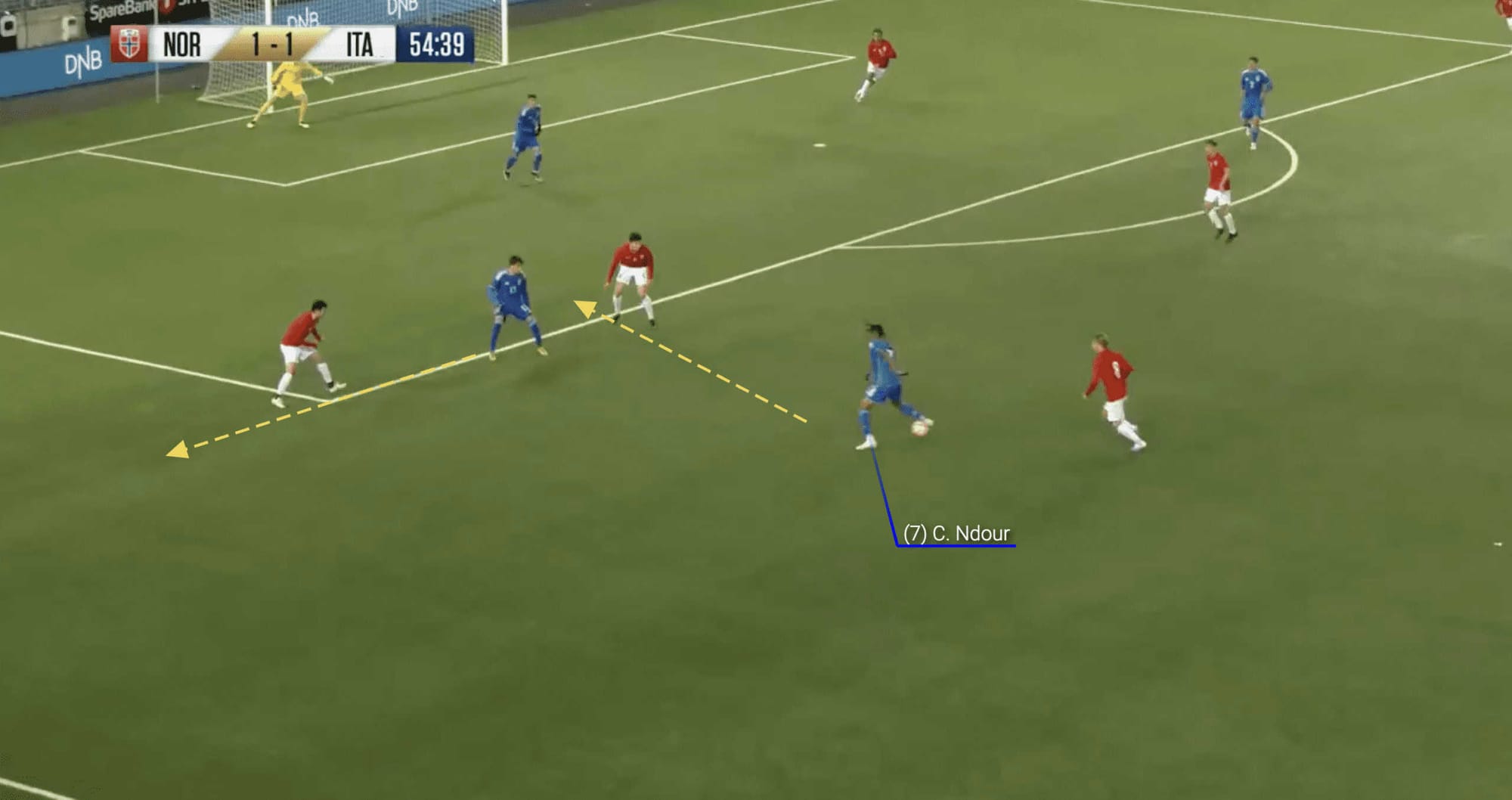

Both Benfica B and Italy U19 employ a high-pressing style of play to regain possession quickly, and Cher Ndour’s athleticism proves to be a valuable asset in this style of play as he possesses the ability to cover the ground rapidly.
This poses a significant challenge for opponents, as they are left with minimal time to make decisions on how to respond.
Figures 1.2 and 1.3 demonstrate a scenario where Italy U19 initiates a high press, resulting in Ndour intercepting the ball.
In response, Ndour’s teammate drifts wide, creating space for the midfielder to exploit.
Therefore the midfielder capitalises on this opportunity by utilising his close control and quick footwork.
He skillfully evades the defenders with his twists and turns before ultimately scoring an impressive curling shot into the top corner of the goal.
Ndour’s combination of speed, agility, and technical abilities allows him to excel in this fast-paced, high-pressing style of play.
His athleticism enables him to win back possession and create scoring opportunities for himself and his teammates through his ability to transition from defence to attack quickly.
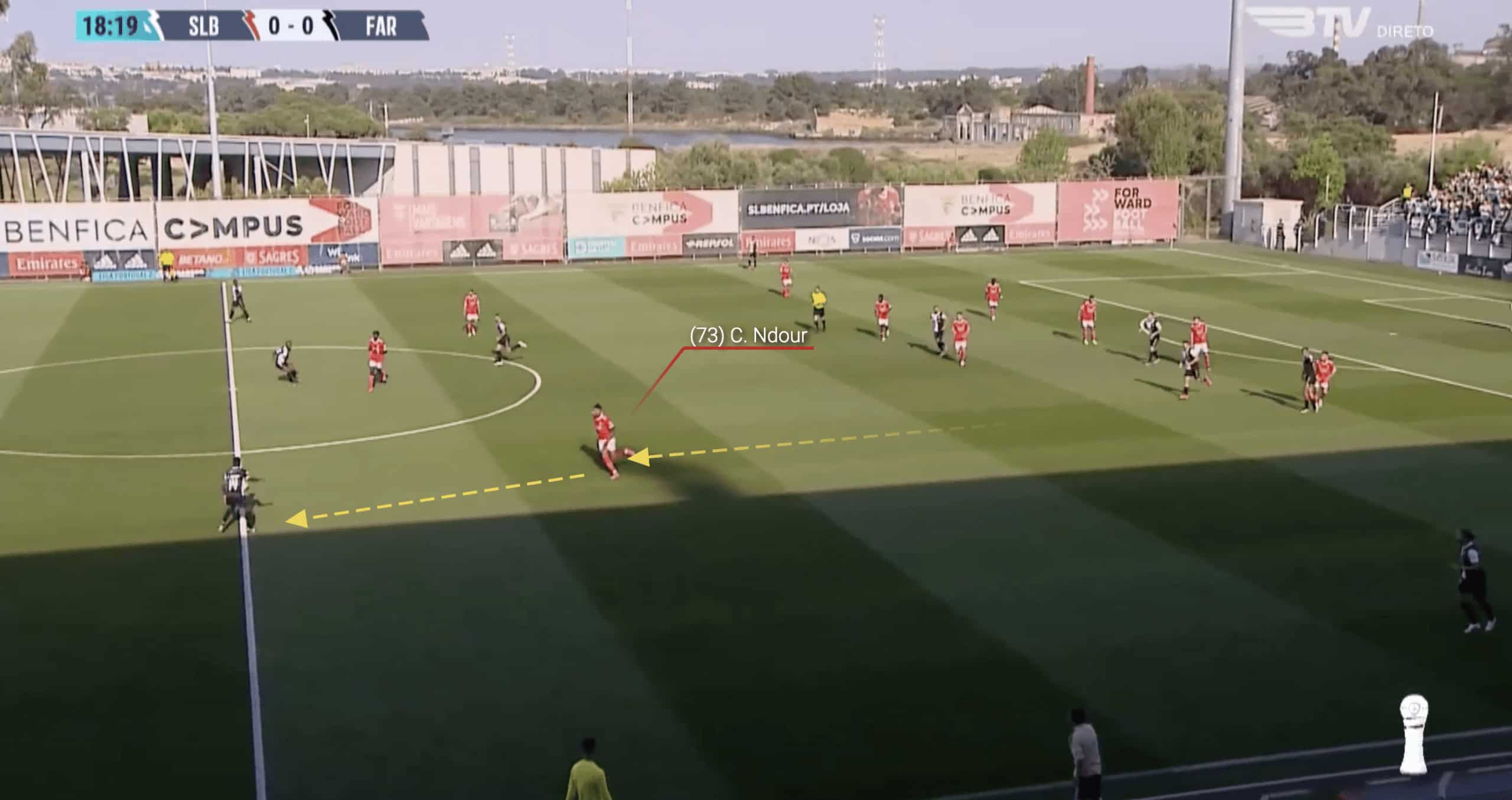
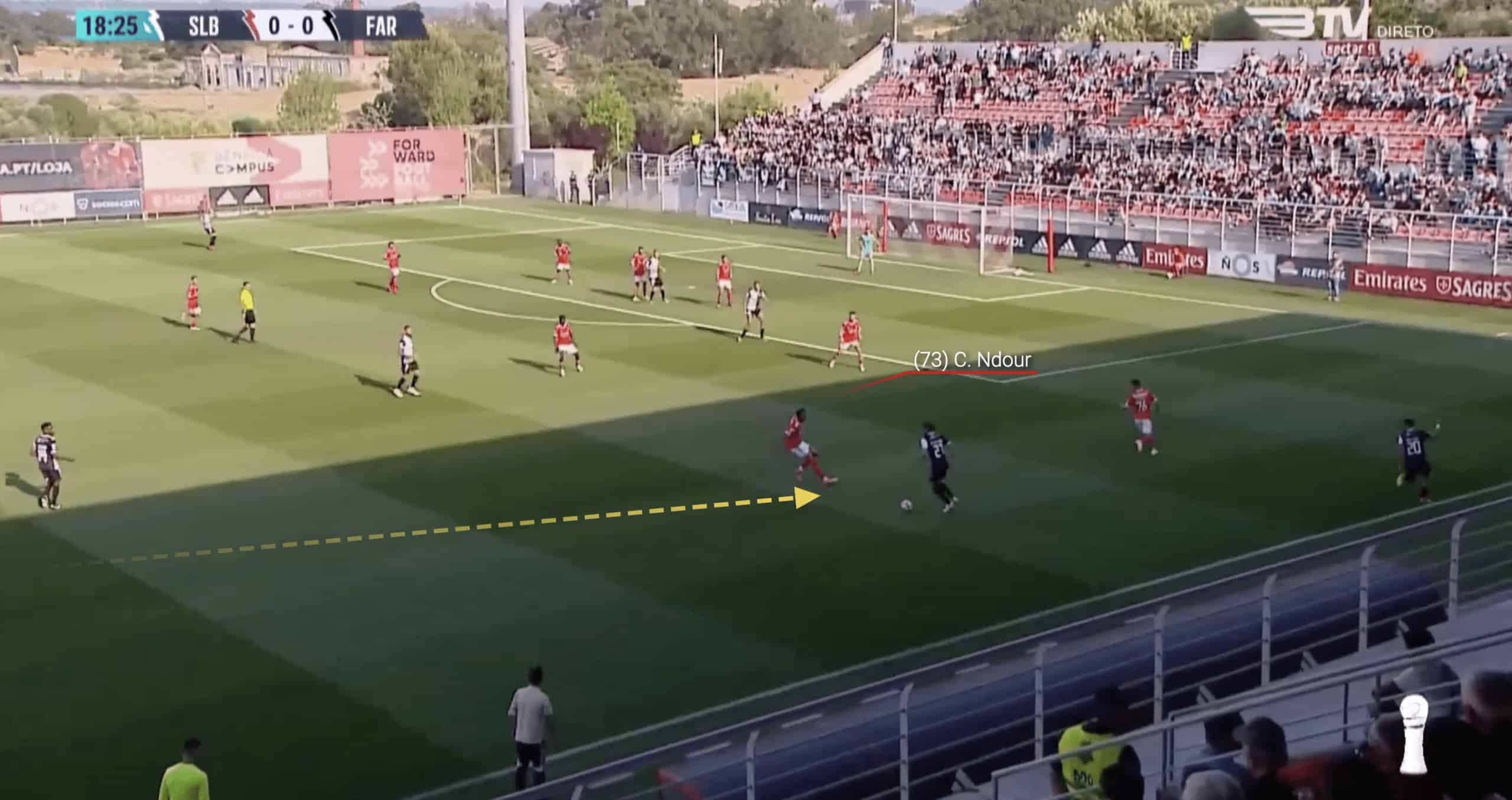
Furthermore, in the defensive phase, Benfica B adopts a 4-4-2 formation, but Ndour is often the player who steps out of this defensive structure to initiate a press.
Sometimes this can be a little reckless as he leaves a vast amount of space behind him which opponents can take advantage of, as it can create a numerical disadvantage in the defensive area, making it easier for the opposition to bypass the press and penetrate through the midfield.
Additionally, Cher Ndour often uses his speed in order to quickly close down the opponent after his initial press has failed, as shown in Figure 1.5; this allows him to cut off any passing lanes as his team looks to regain possession.
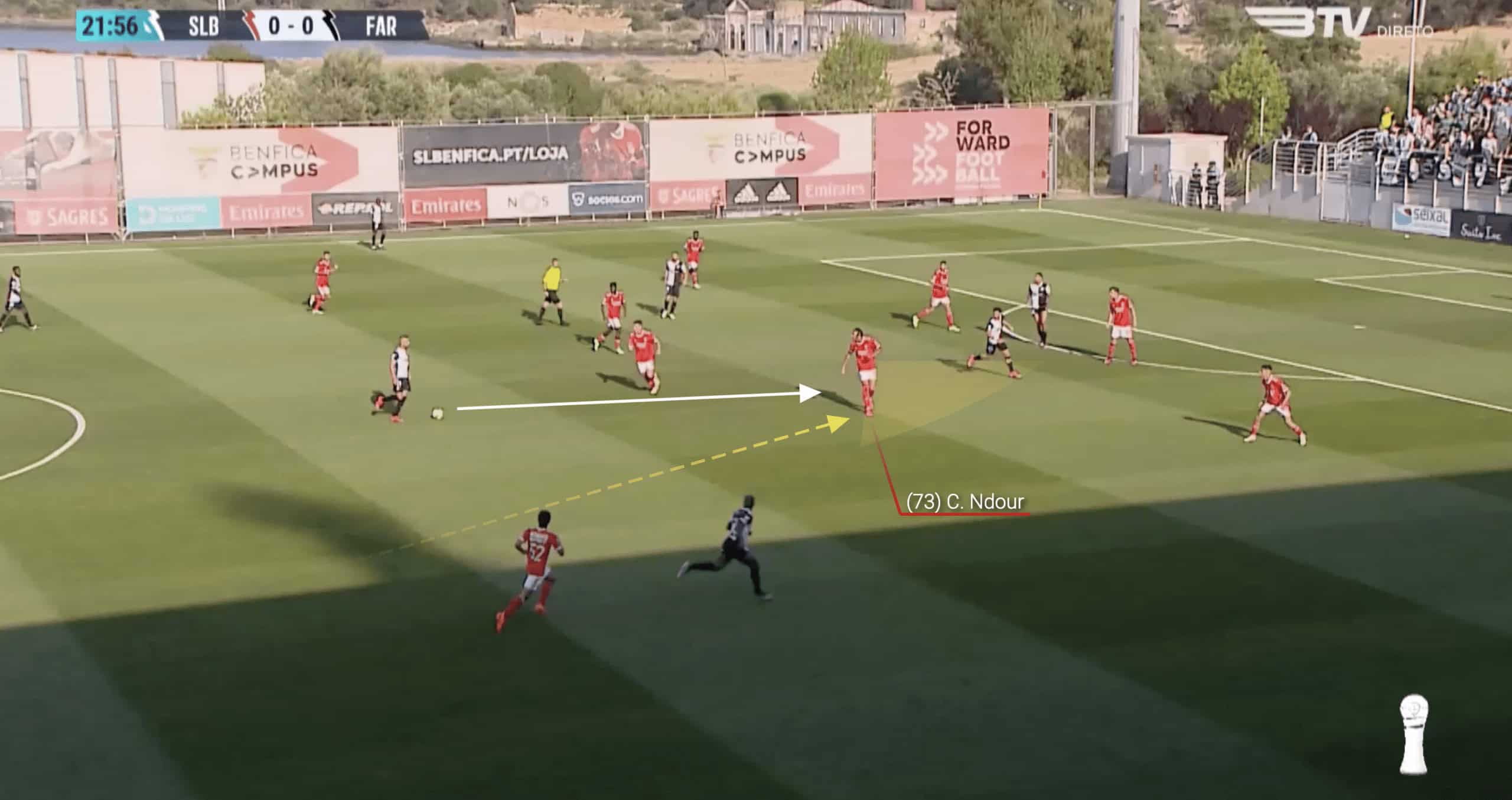
On other occasions, the Italian demonstrates excellent defensive positioning.
In figure 1.6, for instance, Benfica is transitioning from attack to defence.
Ndour takes advantage of his positioning skills by effectively blocking the passing lane to the opposition attacker, completely cutting it off.
Additionally, he ensures that he is in a favourable position to intercept the ball or quickly close down any other opponent if the need arises.
Cher Ndour is a talented midfield prospect who has thrived since playing for Benfica B in Liga Portugal 2.
He is attracting the interest of Ligue 1 giants PSG as Luis Campos leads the overhaul in their recruitment.
Wherever Cher Ndour plays his football next season, he is undoubtedly one to watch.
Miłosz Matysik Scouting Report – Poland U19
The next player we are going to look at in this series of scout reports is Polish central defender Miłoz Matysik.
The 19-year-old currently plays for Jagiellonia Białystok in the Ekstraklasa.
The defender enjoyed a breakout season during the 2021/22 campaign and continued his upward trajectory by going on to make 15 appearances in the league during the 2022/23 season.
In addition to playing as a central defender, Matysik can also play as a defensive midfielder thanks to his impressive skills in possession, which we will discuss in this analysis.
Miłosz Matysik Heat Map

As the heatmap above indicates, Matysik primarily operates as a right-sided centre back in a back four.
He thrives as a ball-playing defender, relishing opportunities to be in possession and utilising his passing ability to initiate attacks and help his team overcome an opposition press when necessary.
The heatmap also reveals to us that he has a high level of activity in the opposition half of the pitch, mainly attributed to his inclination to surge forward and press his opponents—a facet we will delve into further in this analysis.
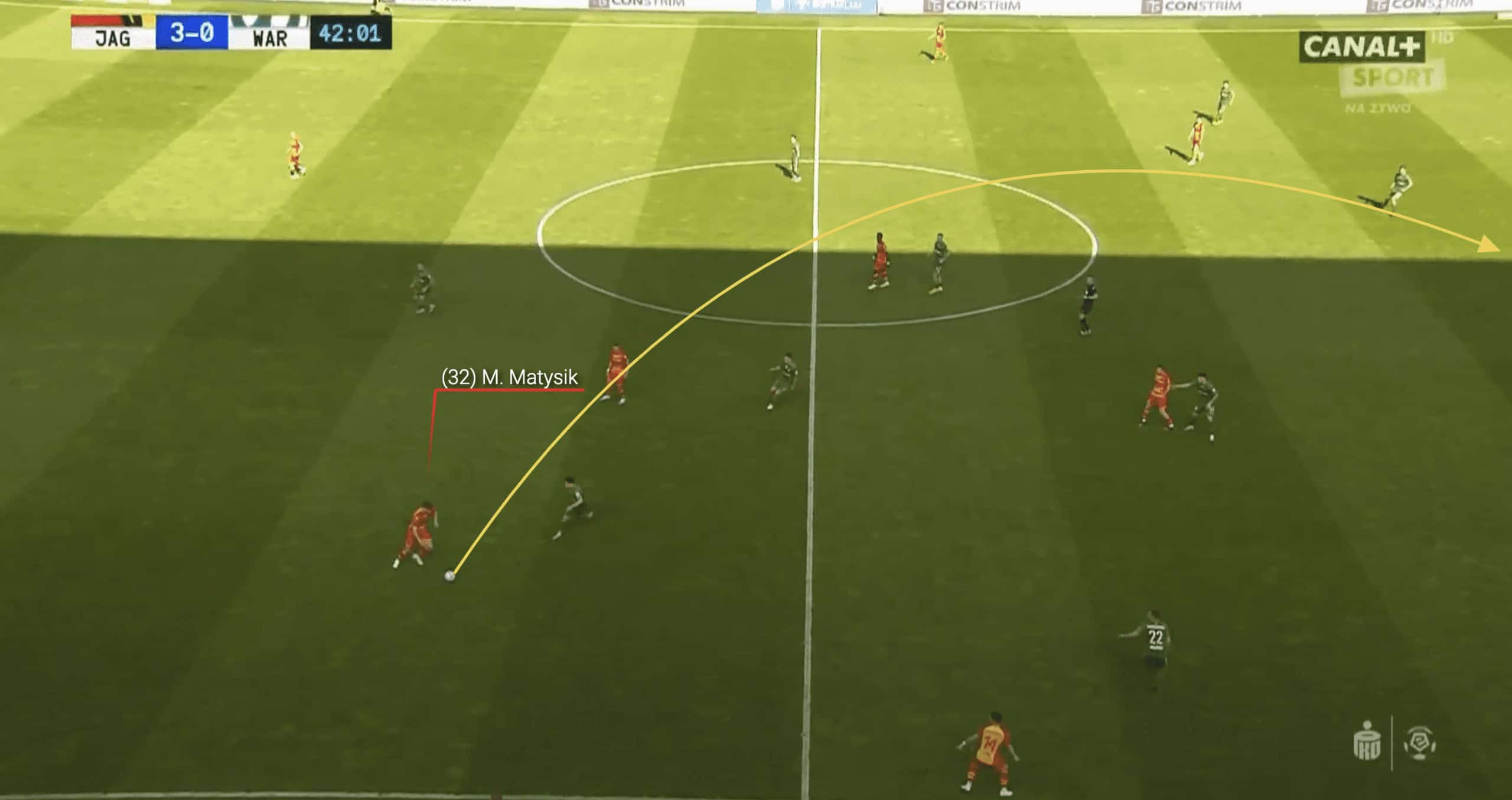
We will begin by highlighting Matysik’s excellent passing range, which really adds an extra dimension to Jagiellonia Białystok’s build-up play from the back.
They can initiate attacks with accurate long-range passes to bypass opposition lines and directly involve the forwards in dangerous positions, as we can see above.
Matysik can look up and see the space where his teammate will be making a run, so he can execute a long pass straight into the attacker’s path, which completely bypasses the opposition defence.
This long passing ability enables the team to quickly transition from defence to attack, catching the opposition off guard and creating opportunities for fast and effective counterattacks.
With a pass accuracy rating of 83.4%, we can infer that the central defender is reliable in possession and often makes wise choices when on the ball.
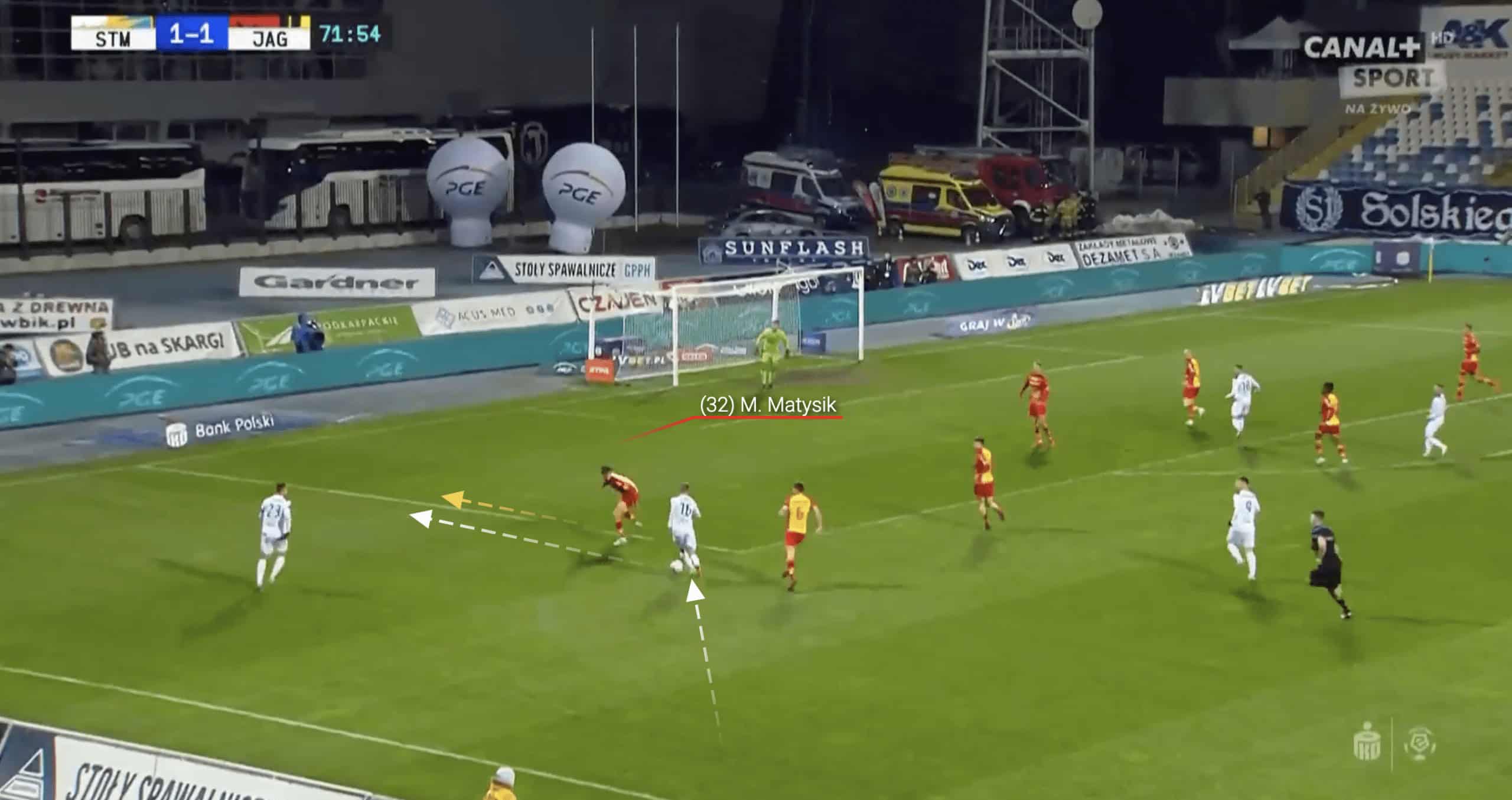
Regarding his defensive abilities, Miłosz Matysik frequently demonstrates that he is an excellent all-around defender.
Standing at approximately 190 cm tall, he presents a challenging obstacle in aerial duels and possesses good physical strength for ground duels.
Notably, the Polish defender exhibits astuteness in his defensive approach, avoiding rash challenges and committing minimal fouls.
Instead, he relies on his positional awareness and body orientation to cut off passing lanes, unsettle opponents, and provoke mistakes.
This intelligent defensive strategy has proven effective, as he maintains an average of 6.01 interceptions per 90 minutes for his club during the 2022/23 campaign.
Figure 2.3 exemplifies Matysik’s defensive acumen.
Recognising the attacker’s intention to move down the flank, he adeptly adjusts his body position to deny the opponent the opportunity to deliver a cross.
As a result, the attacking move is effectively stifled and fails to materialise into a scoring chance.
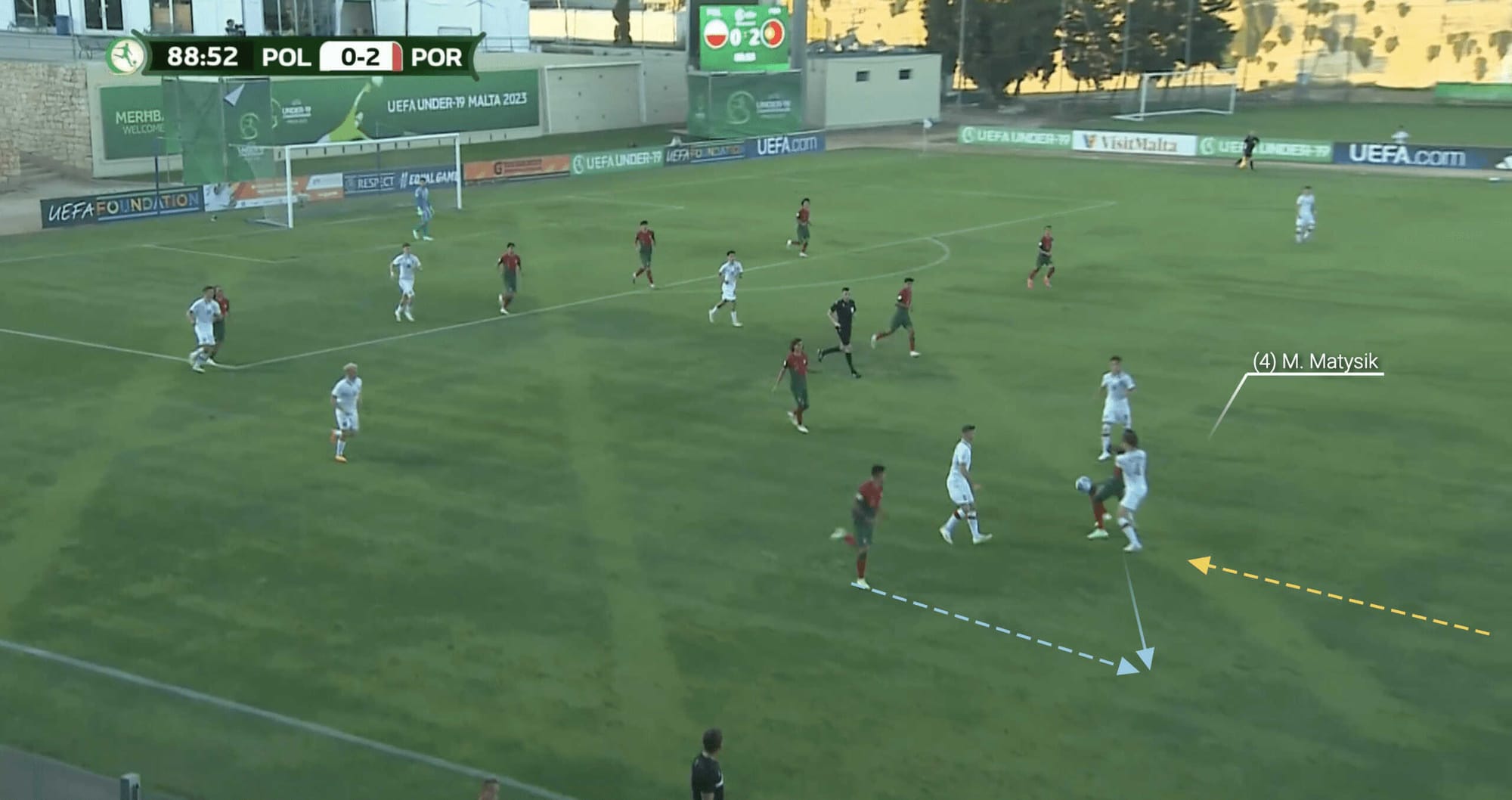
We mentioned previously that Matysik is keen to follow his opponent into the opposition half to initiate a press; this is demonstrated in figure 2.4.
On the one hand, this can be a very effective way of ensuring that his team regain possession and have the opportunity to counterattack quickly.
However, sometimes this proves to be a poor choice, as it allows the opposition to effectively play around him, which takes him out of the game and provides the opponent with a massive amount of space to exploit.
This is what occurs in the scenario shown above; the Portuguese attacker lays the ball off to his teammate, who is able to run into the space vacated by Matysik through his decision to press.
Overall, Matysik is a good defender who plays well under pressure, makes intelligent decisions and is reliable in possession.
It surely won’t be long before we see him making a move to one of Europe’s top 5 leagues.
Stefanos Tzimas Scouting Report – Greece U19
Moving on with our analysis, we will now look at PAOK’s Stefanos Tzimas.
The Greek striker bagged two goals in his team’s entertaining 5-4 loss against Norway on match day one.
At just 17 years old, the young forward shows many signs that he is ready for first-team football, which undoubtedly makes him one of the hottest prospects in Greek football.
Stefanos Tzimas Heat Map

The heat map reveals that Tzimas has a remarkable ability to cover a significant amount of ground, particularly in the attacking third.
He exemplifies a player who puts in a tremendous effort for his team, frequently dropping deeper to draw opposition defenders and consequently creating space for his teammates to make off-the-ball runs.
Moreover, he adeptly positions himself in the half-spaces, effectively linking up play and occupying practical pockets of space.
His considerable pace further enables him to exploit opportunities by making well-timed runs behind the defensive line.
Later in this analysis piece, we will delve deeper into this aspect.
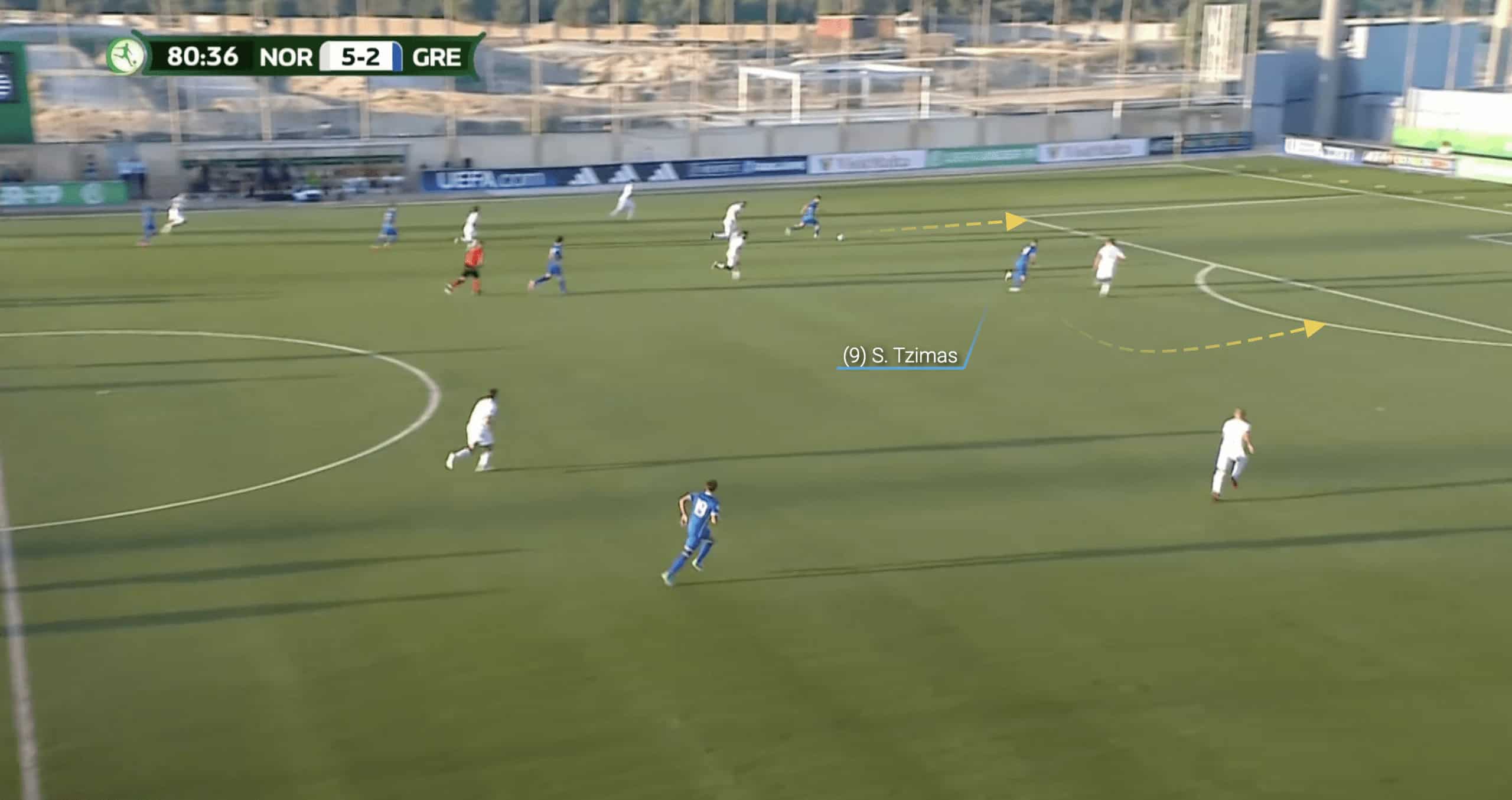
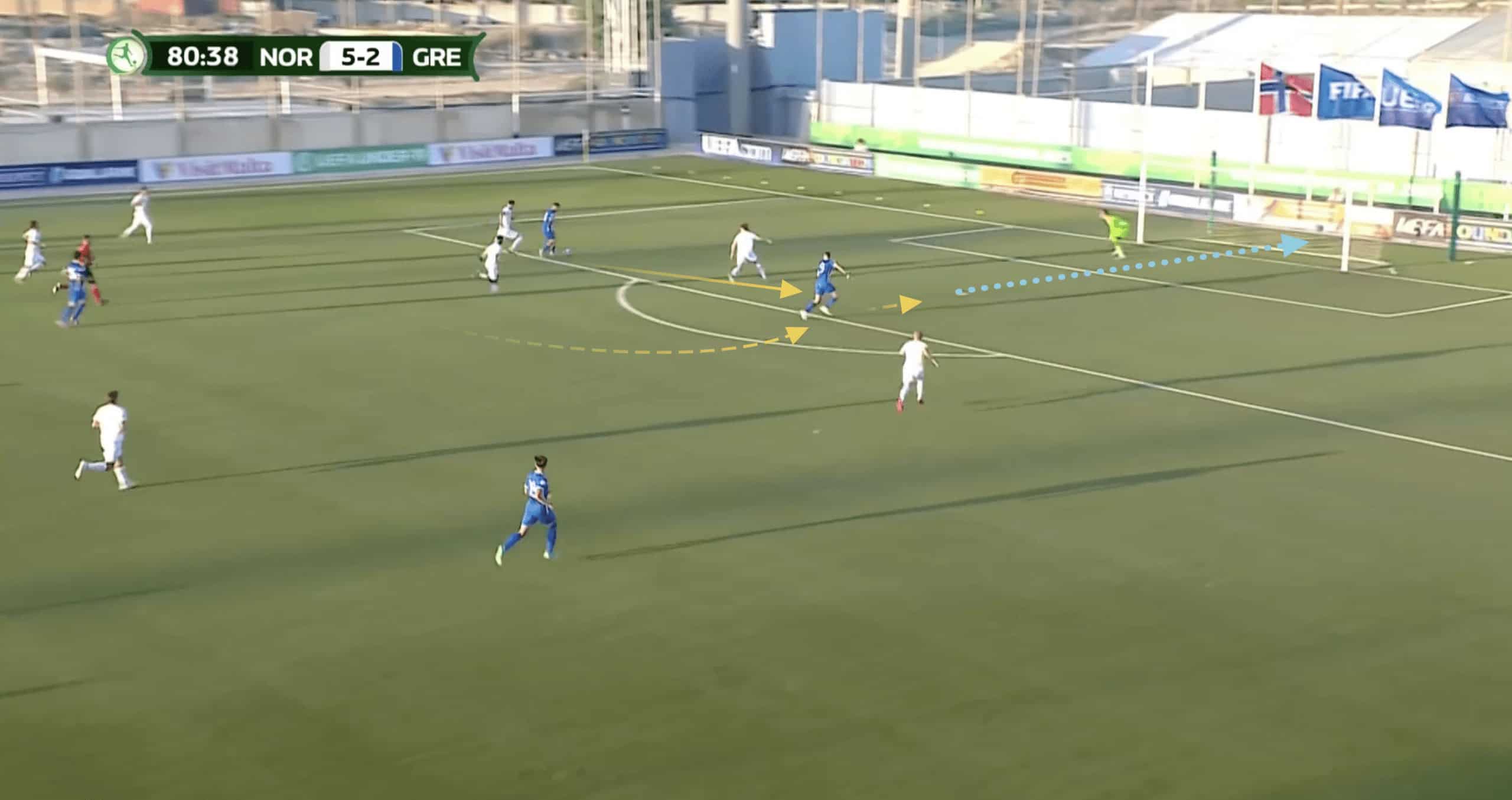
Here in figure 3.1, we can witness Tzimas’ off-the-ball movement as he realises he needs to get on the goal side of the defender and holds his run slightly in order to breeze into the opposition penalty area undetected.
When the cross is played into his feet, he is able to easily place it beyond the goalkeeper and grab another goal for Greece.
Focusing on his off-the-ball movements, we can understand that by constantly being on the move and actively seeking opportunities, Tzimas can create space for himself and his teammates, making it harder for the opposition defenders to track and mark him effectively.
As mentioned previously, his dynamic movements allow him to pull defenders out of position.
Additionally, he will drop deeper and make the runs, which lure defenders away from their designated areas, thus disrupting the defensive shape.
Secondly, by intelligently positioning himself between the opposition’s defensive lines, known as the half-spaces, Tzimas becomes a valuable link between midfield and the final third.
This positioning allows him to receive passes in dangerous areas, where he can then either initiate attacks or combine with teammates to create scoring opportunities.
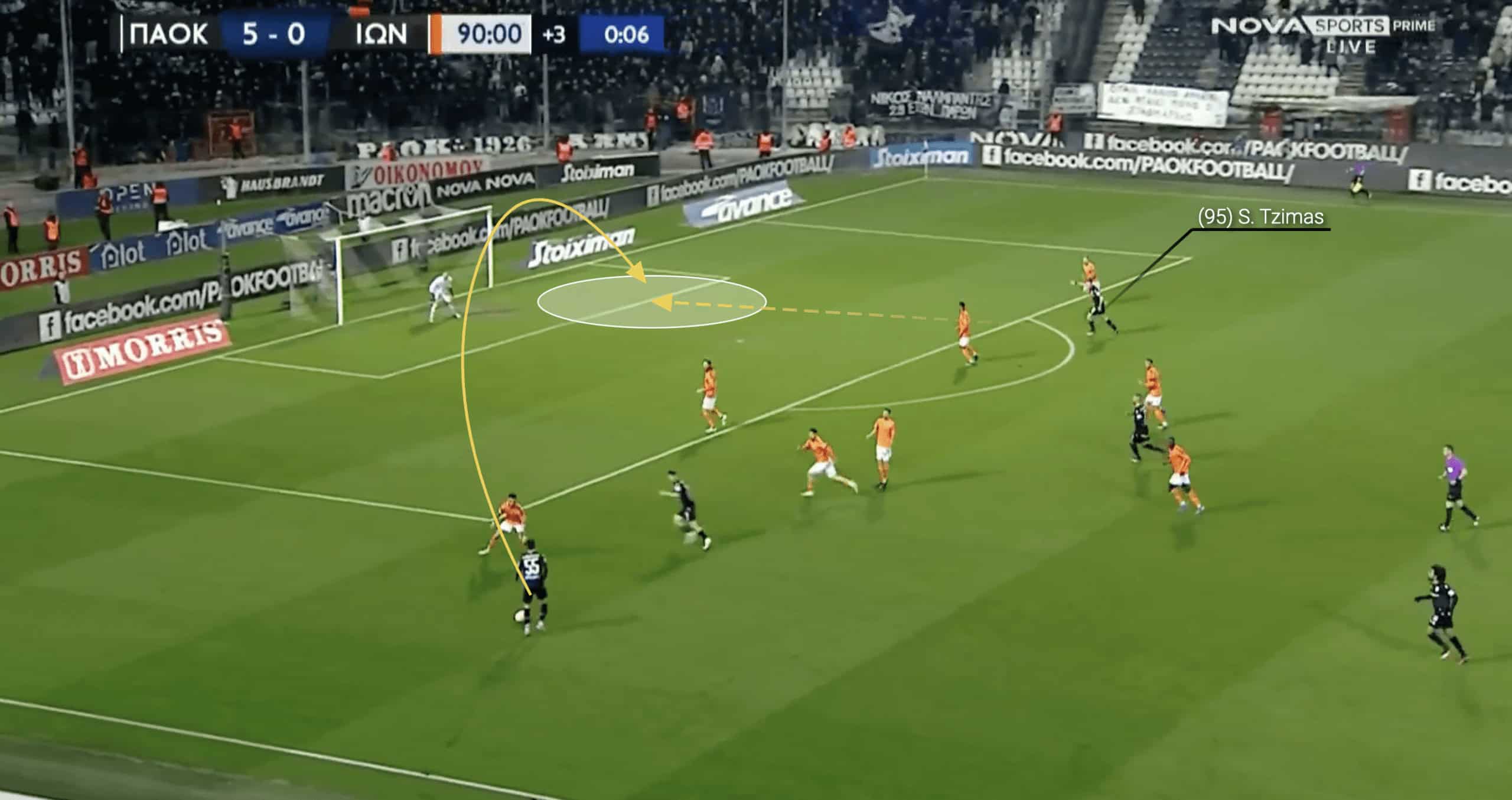
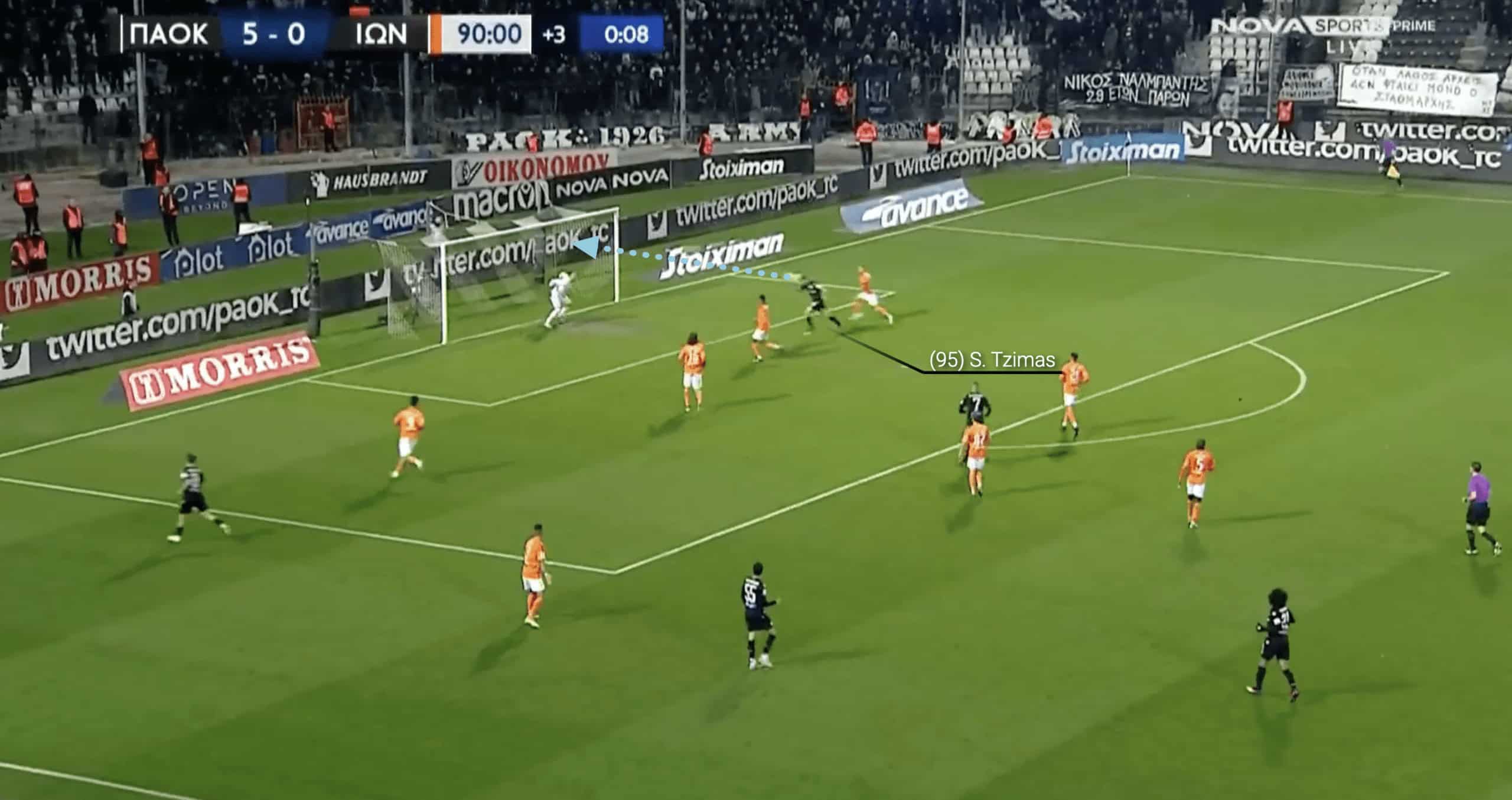
Standing at approximately 185cm tall, Tzimas possesses significant aerial abilities that make him a great asset both offensively and defensively.
We can see here in figures 3.3 and 3.4 how the young striker understands how to time his runs into the box to perfection.
Additionally, he possesses an excellent ability to leap above his opponent; this also makes him valuable when defending set pieces, as he also has good physical strength to win aerial duels.
Furthermore, the forward adds a significant goal-scoring avenue to his team’s repertoire with his ability to outjump defenders and direct headers towards the goal.
This means that he becomes a potent weapon in converting crosses, corners, and free-kicks into goals, as demonstrated above.
This not only increases the team’s goal-scoring potential but also places additional pressure on opposing defences, as they must be cautious in their marking and defensive positioning.
Additionally, the 17-year-old Greek striker can potentially become a valuable asset in terms of hold-up play.
He can win long balls and aerial duels, effectively bringing teammates into play by flicking on headers or controlling the ball with his chest or feet.
The ability to hold up the ball allows the team to establish a presence in the opposition’s half, maintain possession, and initiate attacking moves from deeper positions.
It also allows supporting players to make runs and create scoring opportunities from knockdowns.
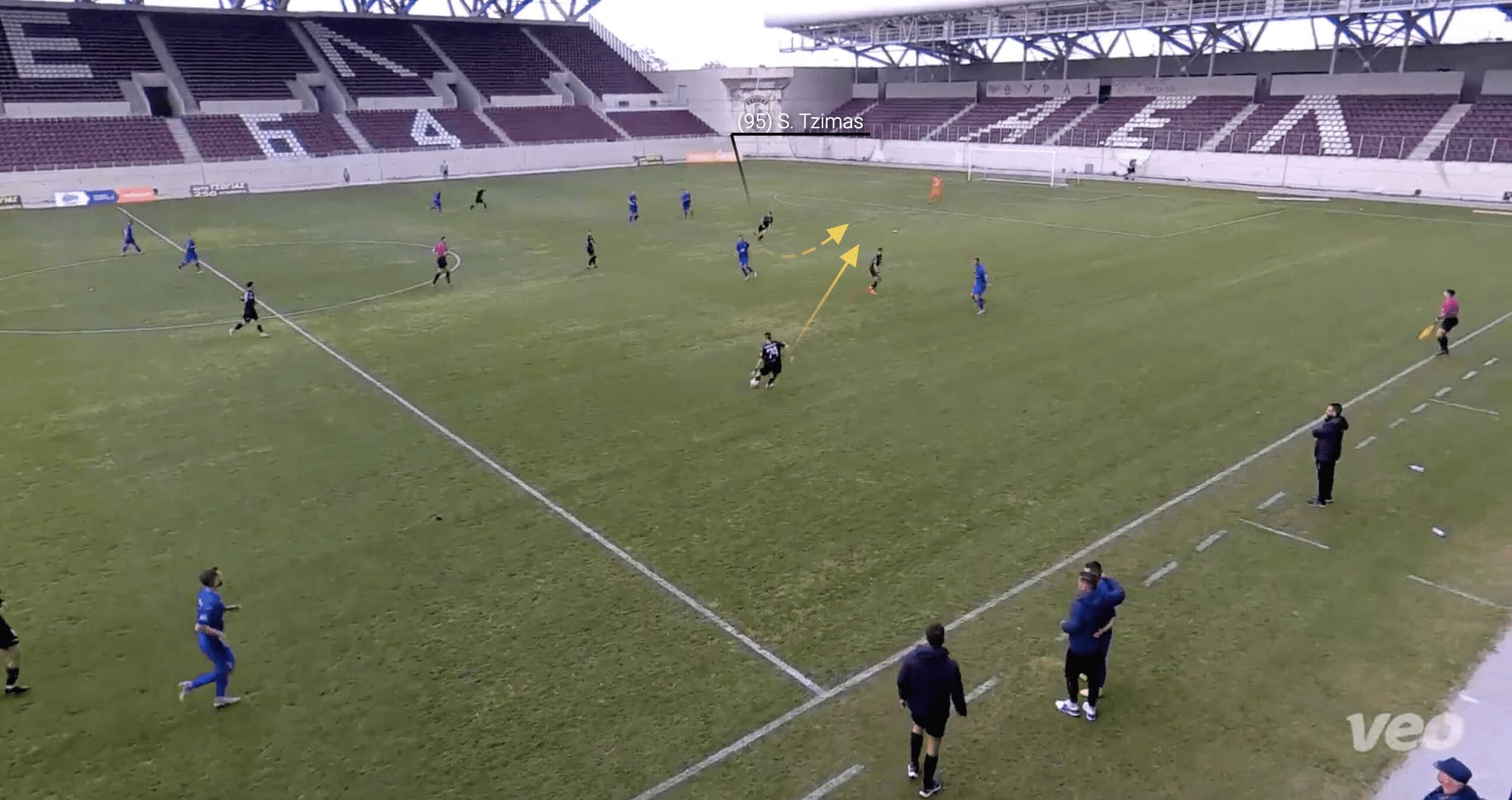
Finally, we can see how Tzimas makes runs in behind the defensive line, which allows teammates to find him with line-breaking passes which means he is often put through 1v1 with the opposition goalkeeper.
This requires a combination of anticipation, speed, and intelligent positioning, which allows the young striker to exploit gaps in the defence and means that he is a constant threat in behind.
Stefanos Tzimas Ball Progression Map

Before we wrap up this mini scout report, the data visual above shows us the areas where the ball progression of Tzimas occurs on the pitch.
The talented striker has averaged 2.97 progressive runs and 6.75 dribbles per 90 throughout the 2022/23 campaign, where he mostly played in the Super League U19 league but also made appearances for PAOK B and the first team.
As Tzimas possesses strong dribbling skills, this really adds an element of unpredictability to his attacking play.
He can take on defenders and change direction quickly, which keeps the opposition guessing and forces them to adjust their defensive strategies.
This unpredictability opens up space for other attacking players, as defenders are often drawn towards the striker, creating opportunities for quick passes and combination plays.
Overall, Stefanos Tzimas is a striker that already looks like he could play a role in the PAOK first team and at 17 years old, he is only going to get better.
Rodrigo Ribeiro Scouting Report – Portugal U19
Moving on, we will now look at another striker; this time, we will focus on Rodrigo Ribeiro, who plays for Sporting CP and Portugal U19s.
In many respects, Ribeiro is a traditional number 9, but he has such a well-rounded skill set that he can play anywhere across the front line and still be incredibly influential on the game.
The 18-year-old has enjoyed a fruitful season playing for Sporting CP B in Liga 3 and the UEFA Youth League.
He scored 17 goals and contributed two assists.
Rodrigo Ribeiro Heat Map
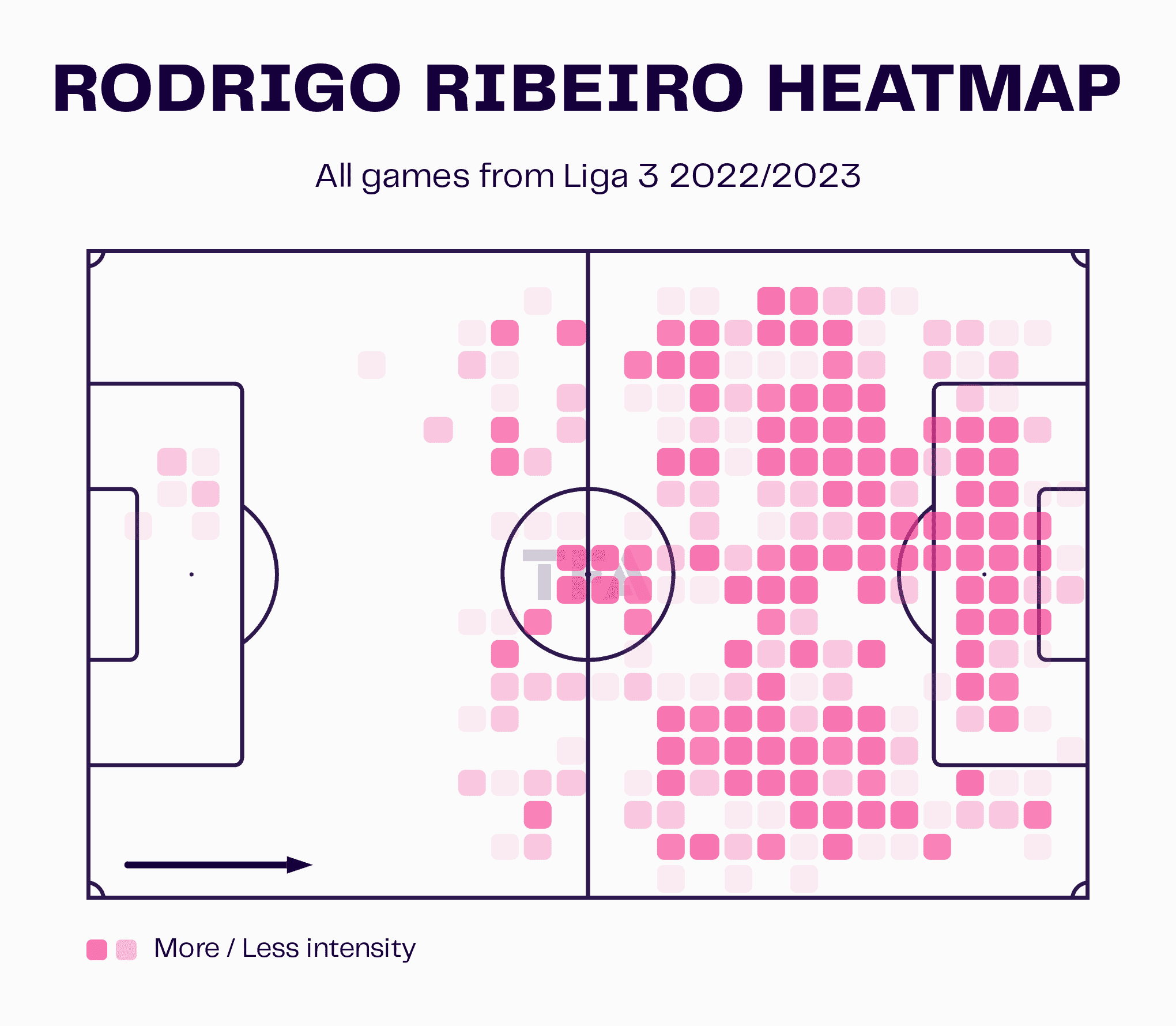
When in possession, Ribeiro actively drifts out to the wide areas and then cuts inside, facilitating rotations between the front line.
He purposefully drops deeper to establish himself as the link between midfield and attack.
Watching Ribeiro, one can sense his genuine desire to make things happen on the pitch.
His exciting attacking style is characterised by a combination of pace and trickery, making him a captivating player to watch.
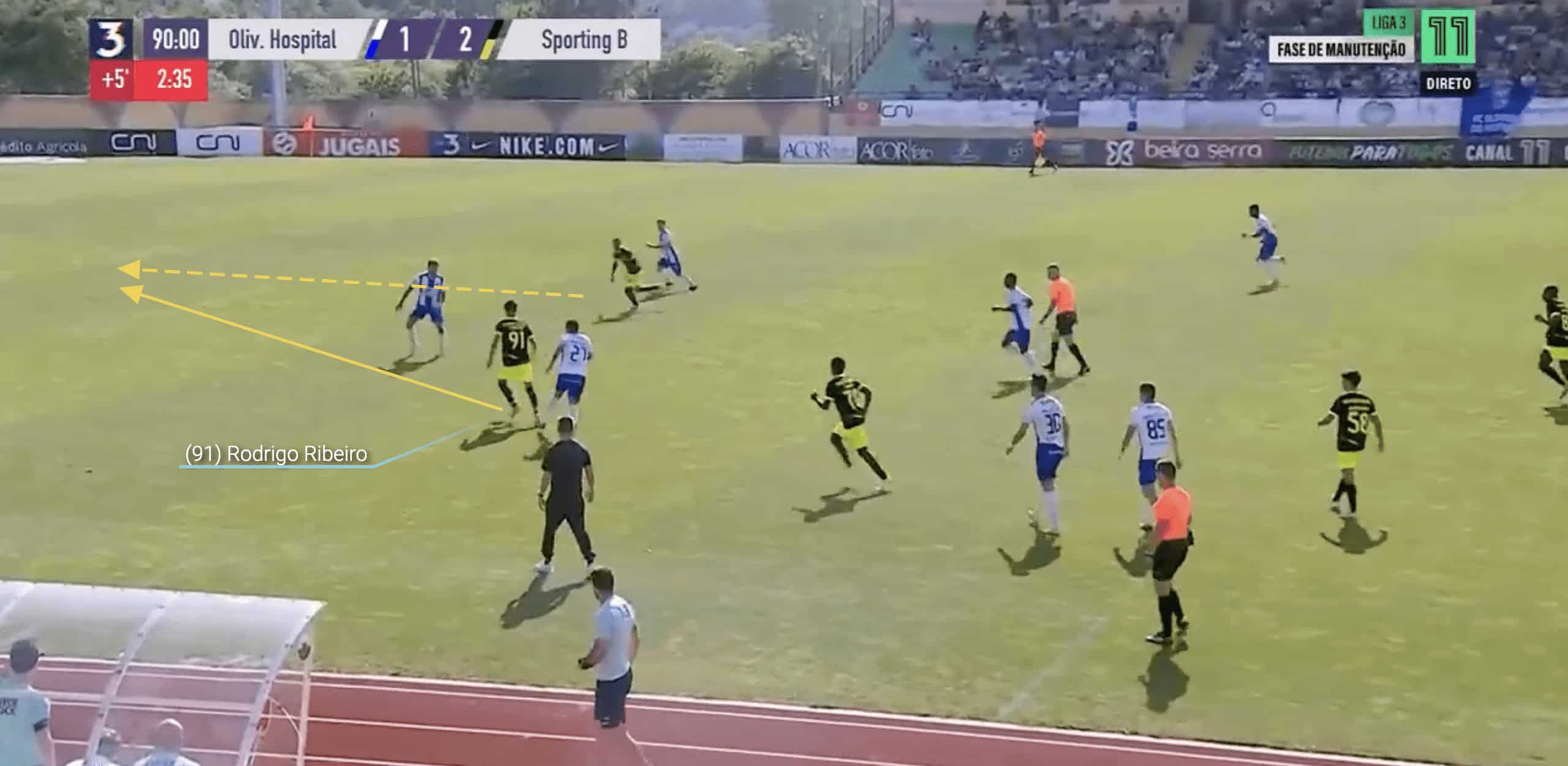
Here in figure 4.1, we can see that Ribeiro has drifted towards the left wing in order to receive the ball.
This has created space for a teammate to run in behind the opposition’s defensive line.
The Sporting CP man is able to find him with a well-timed pass which allows his teammate to go through 1v1 with the goalkeeper.
As we can see, Ribeiro drifts to the wider areas so that he can initiate effective rotations and positional interchanges with other attacking players.
He can create opportunities for their teammates to occupy the central areas by moving into wide positions.
This dynamic movement and interchangeability among the front line make it challenging for defenders to mark specific players and predict their movement, leading to increased confusion and defensive vulnerabilities.
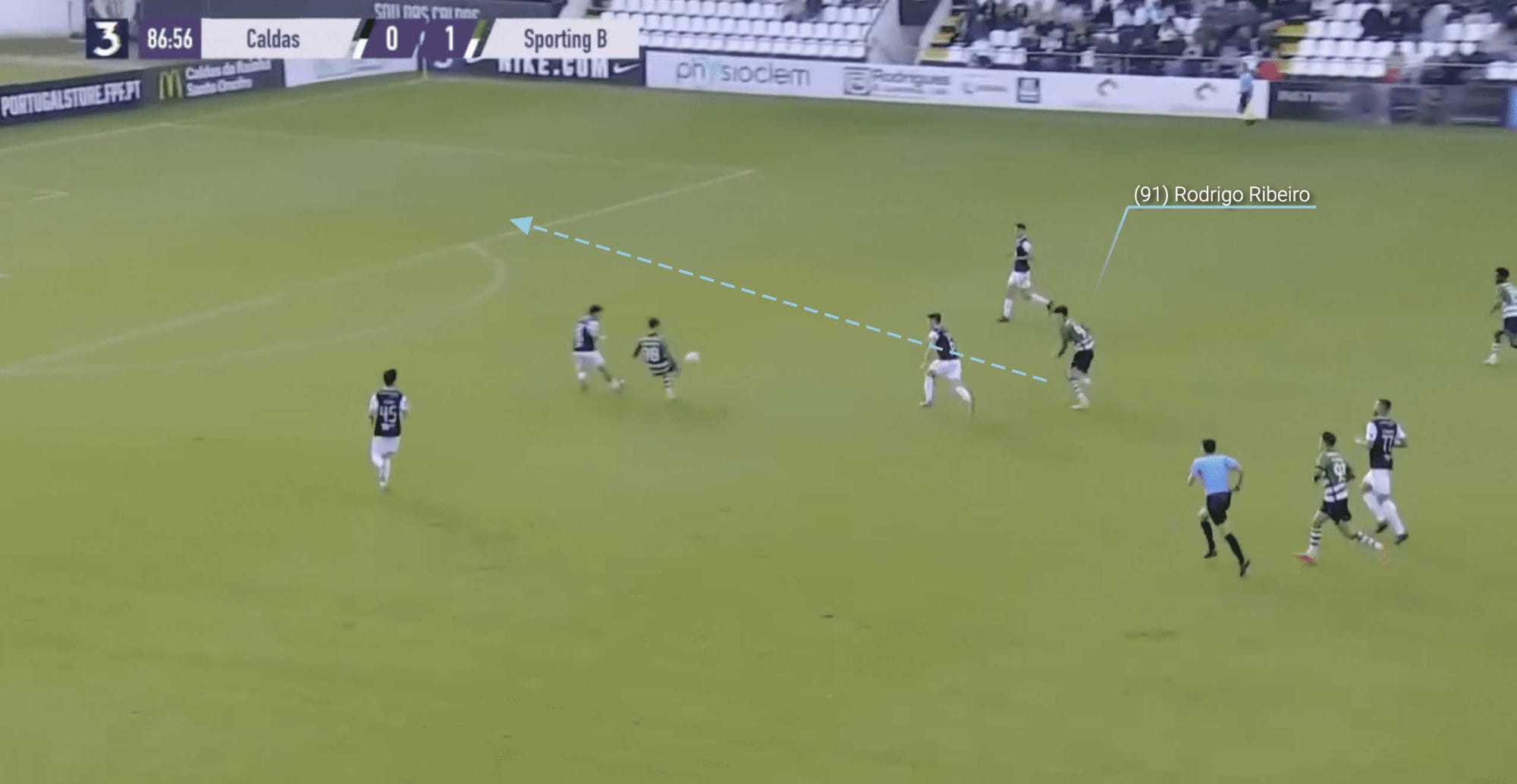
Ribeiro is excellent in the air, having won 53.8% of his aerial duels in the 2022/23 season.
Here, for example, Ribeiro has won the initial header and managed to flick the ball onto his teammate.
However, the Portuguese forward doesn’t rest after that — he immediately looks to make a run into the penalty area to provide an outlet for his teammate.
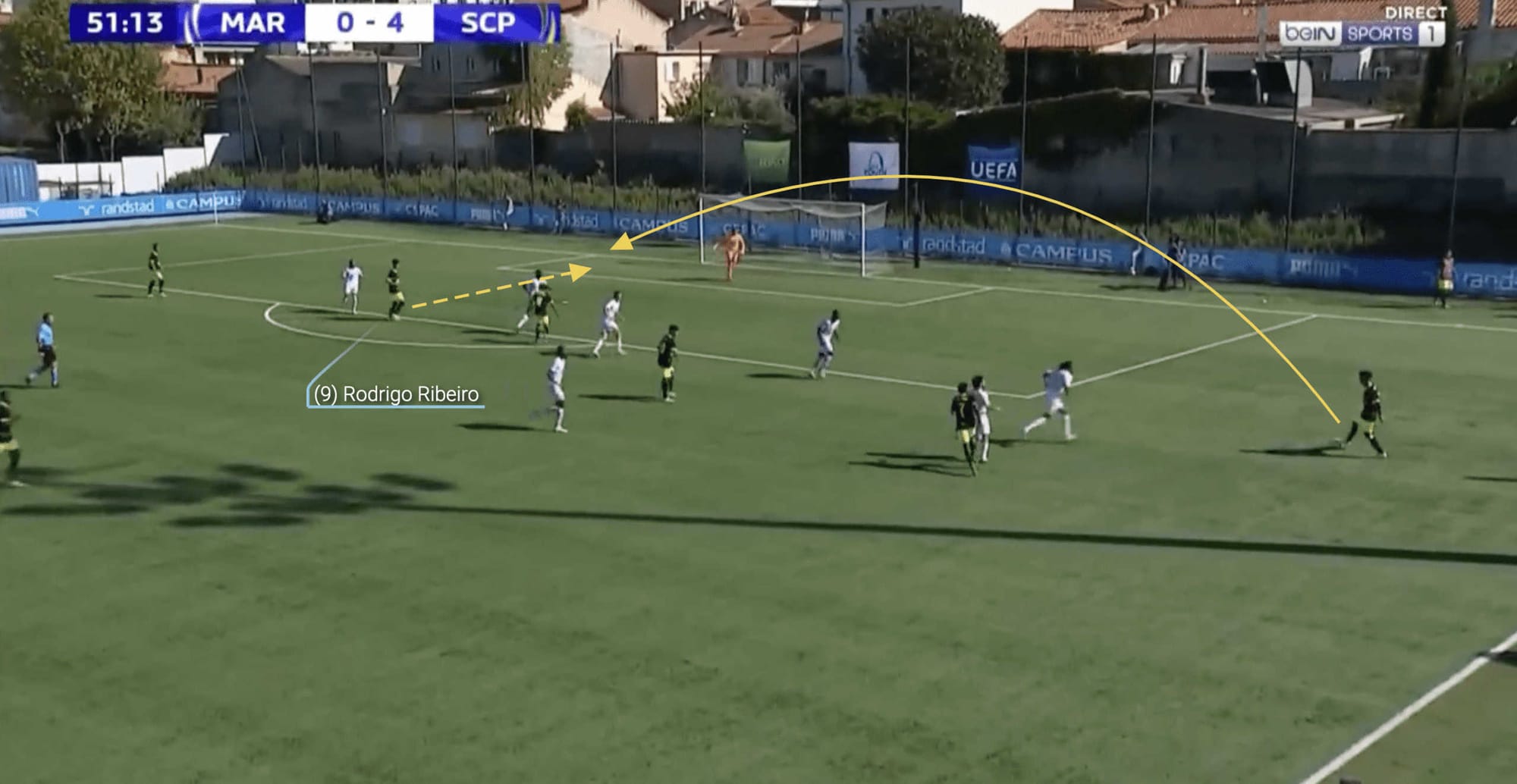
Additionally, Rodrigo Ribeiro is a perfect target for crosses as he actively anticipates and positions himself strategically within the penalty area to be in the optimal position for incoming crosses.
As shown in figure 4.3, he is able to make runs in between the central defenders, which means it is difficult for them to pick him up and gives him a better chance of connecting with the ball.
Ribeiro then utilises his physical presence and positional awareness to outmanoeuvre defenders and gain an advantage in the air.
With his active movement and timing, the Sporting CP player actively attacks the ball when crosses are delivered, using his heading ability to direct it towards the goal.
His adept aerial skills allow him to generate power and accuracy, making him a constant threat in the box.

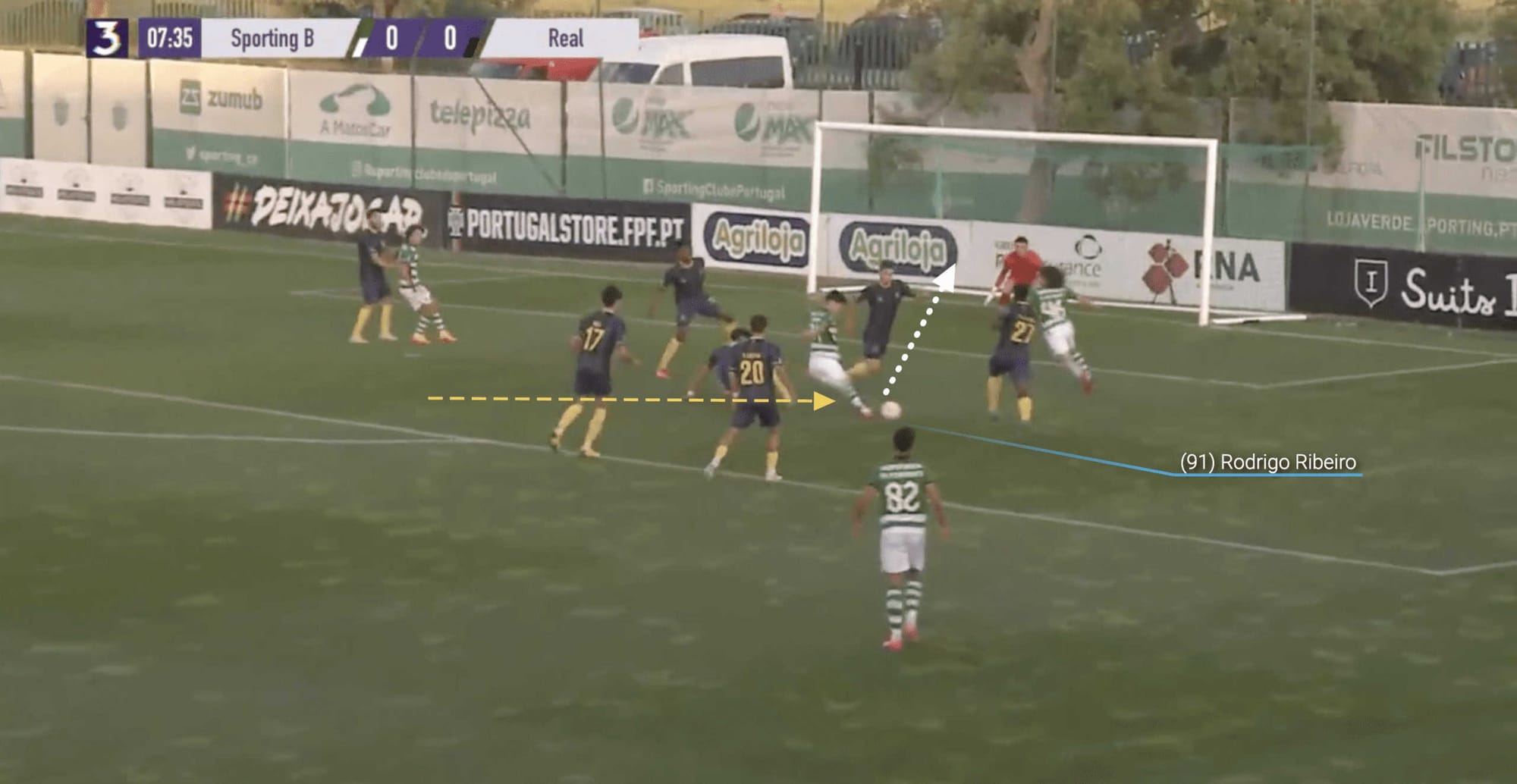
Ribeiro possesses an excellent first touch, as demonstrated in figure 4.4, where he is able to bring the ball down with ease and ensure that the opposition’s defensive players are unable to dispossess him.
An excellent first touch allows the young striker to maintain possession and gain control of the ball quickly.
When receiving passes, whether they are ground balls or aerial deliveries, an adept first touch enables Ribeiro to bring the ball under control smoothly and efficiently.
This close control ensures that he can retain possession, even when under pressure from opposition defenders, creating opportunities for the team to build and maintain attacking momentum.
Moreover, by controlling the ball with finesse and accuracy, he can manipulate the positioning of defenders, creating separation and openings in the opposition’s defensive structure, as seen in figure 4.5.
The extra space allows the striker to either initiate attacking moves or set up scoring opportunities for themselves or their teammates.
Overall, Rodrigo Ribeiro has all the qualities to be a well-rounded striker at a top level which is why he is undoubtedly one to watch for the future.
Niklas Ødegård Scouting Report – Norway U19
We move on to look at Norway U19 player Niklas Ødegård.
The highly-rated midfielder is incredibly versatile, as he has been deployed in several positions at Molde so far this season.
Ødegård has played as a right-sided central midfielder of a midfield three, a winger, and a false 9.
Niklas Ødegård Heat Map
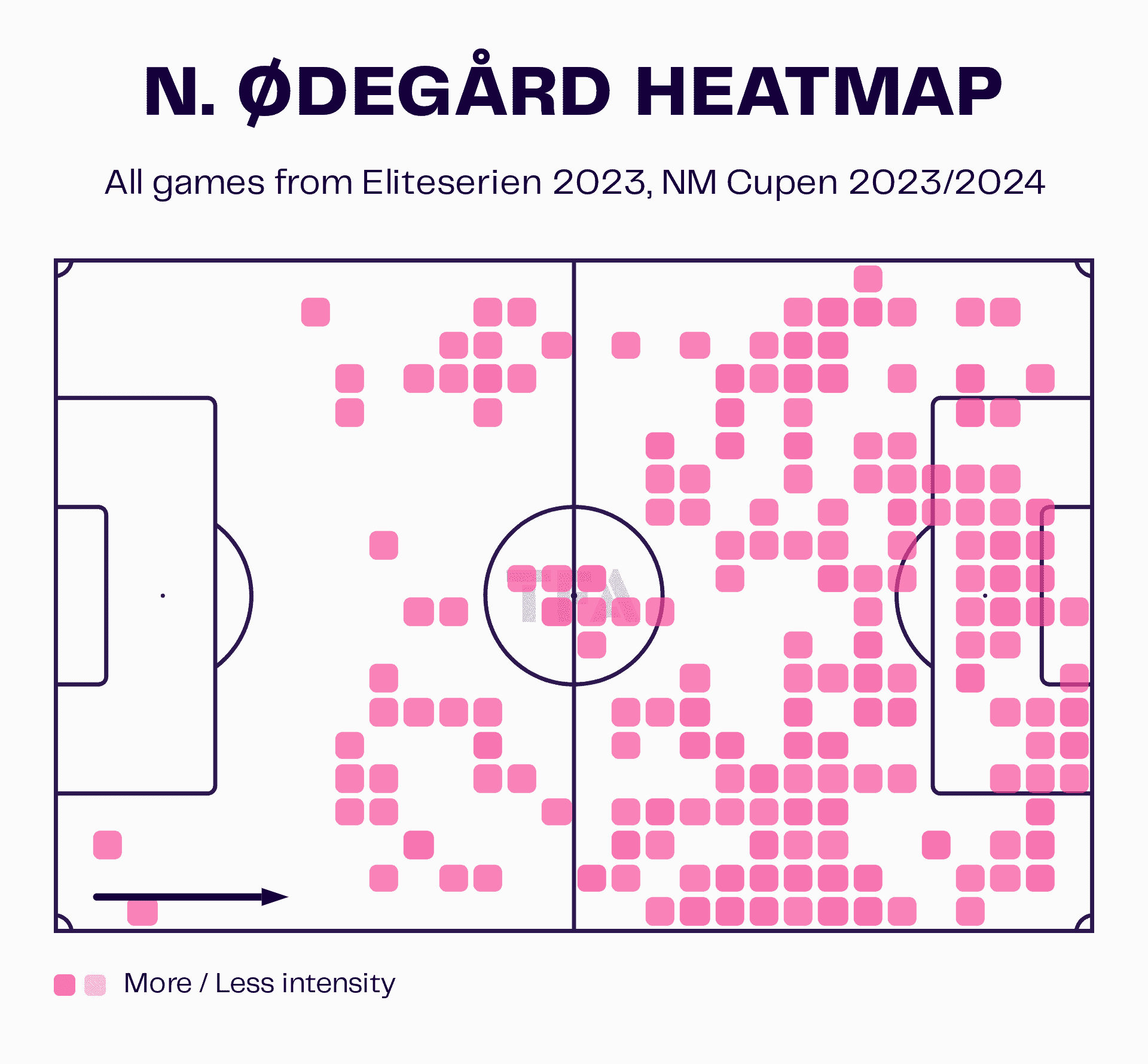
The Norwegian’s heatmap is demonstrative of the fact that he has played in various roles this season.
One thing we can infer is that he is most active in the midfield and attacking third.
He is also very active in the penalty box; an essential element of Ødegård’s play is his ability to make late runs into the area, which adds an extra attacking option for the team.
His arrival in advanced positions provides an additional target for crosses, through balls, or cutbacks from wide areas.
This participation in the attacking phase increases the team’s goal-scoring potential.
It adds unpredictability to the offensive play, as defenders must account for the Molde midfielder’s presence in the box.

Here, we can see Ødegård making a late dart into the penalty area, and as a result, he is able to get himself on the scoresheet for Norway.
His direct involvement challenges the opposition’s defensive organisation, making it harder for them to focus solely on marking the strikers.
Therefore, his off-the-ball movement not only creates space for teammates but also adds another dimension to the team’s attacking strategy, actively unsettling and exposing defensive vulnerabilities, which subsequently results in him scoring a goal.

Ødegard has a wonderful ability to position himself between the defenders, which forces them to either stand off and allow him to receive the ball, as shown above, or they commit and look to press, which will enable Ødegård to link up with teammates, as shown below in figure 5.3.
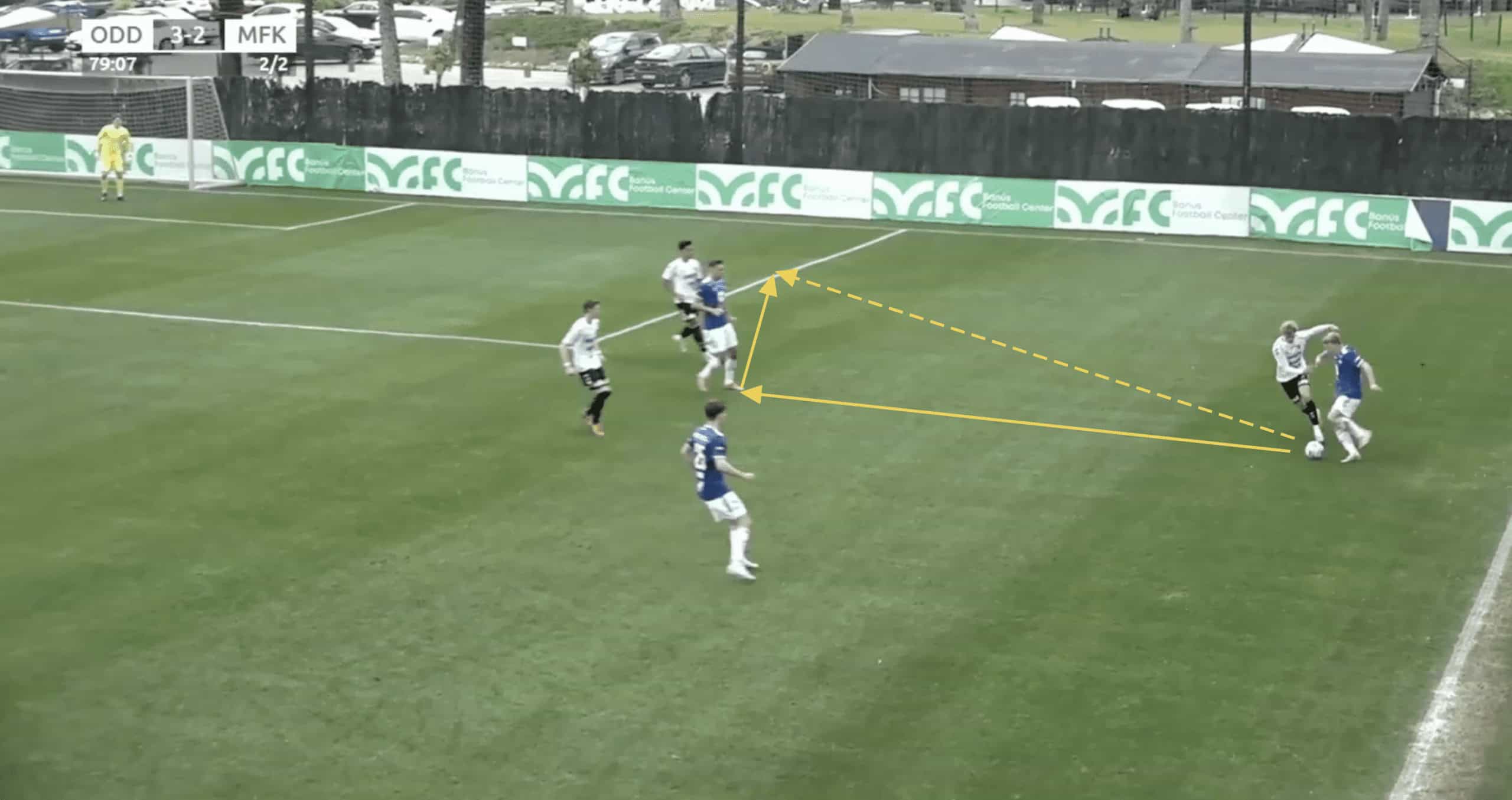
Additionally, Ødegård’s good positioning facilitates seamless connections with teammates.
By being in the right place at the right time, the midfielder becomes a reliable outlet for their teammates to pass to and play off of.
This readiness to receive the ball enables them to utilise quick passing combinations, providing fluidity to the team’s attacking play.
By linking up well with teammates, the Norway midfielder ensures efficient ball circulation, opening up spaces and creating opportunities for penetrating passes or runs.
Furthermore, good positioning contributes to Niklas Ødegård’s ability to read the game and anticipate play.
He demonstrates that he is able to understand the flow and patterns of the match.
Therefore he can actively position himself in areas that maximise his impact.
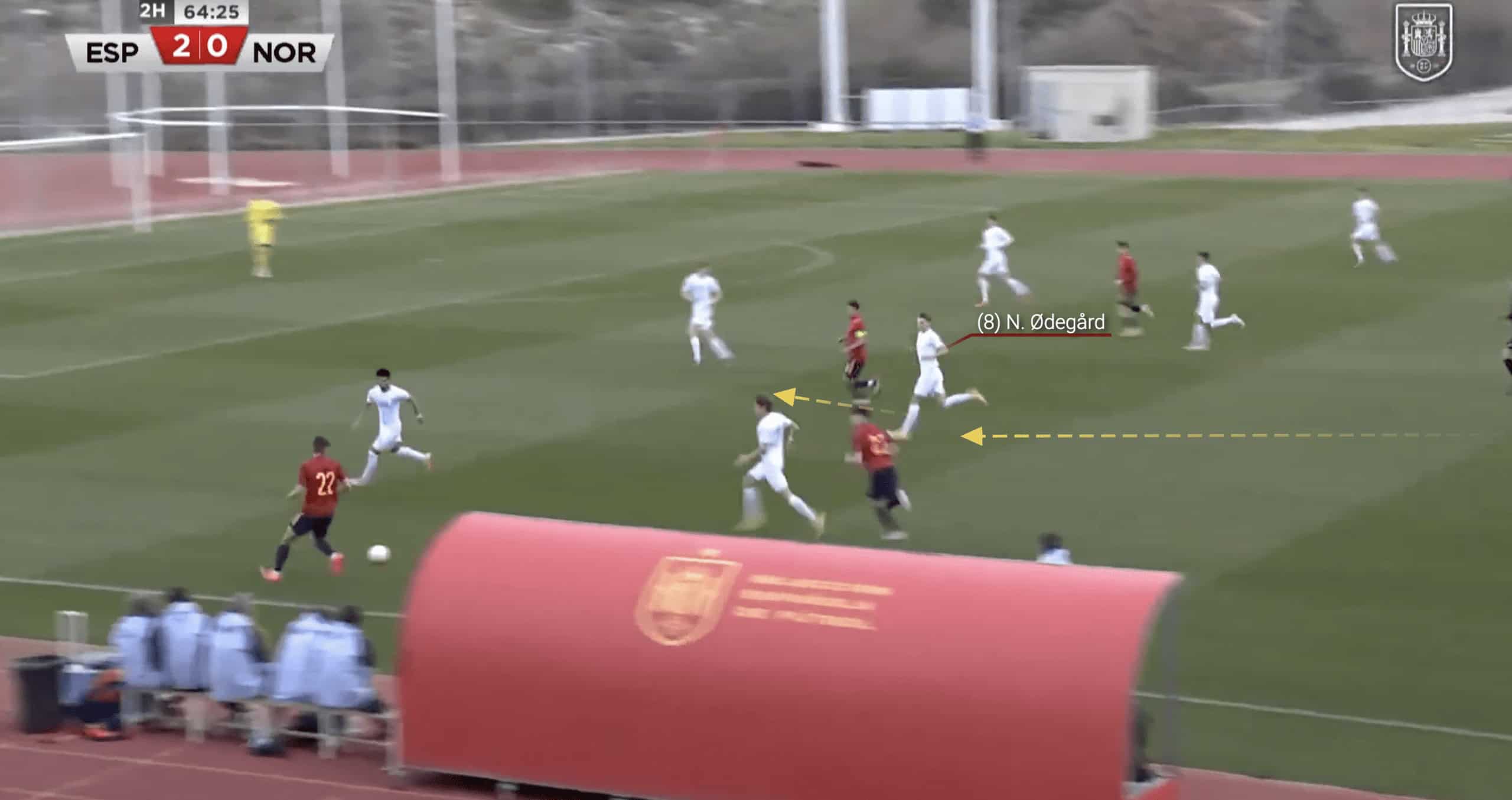
Defensively, Ødegård does not shy away from his responsibilities and always ensures that he tracks back and follows his opponent.
His positioning frequently ensures that he is able to cut off passing lanes and prevent the opposition from playing through the lines.
As seen in figure 5.4, the Norwegian possesses a good burst of pace, enabling him to track back with relative ease and ensure that the opposition cannot build an attack.
By tracking back, the midfielder provides additional defensive cover to the team.
This is particularly important when the team’s defenders are outnumbered or out of position.
Ødegård can fill the gaps, disrupt the opponent’s attacking play, and prevent them from advancing into dangerous areas.
Overall, the young midfielder has a lot of potential; it is highly likely that he will break through and become a regular starter at Molde over the coming seasons, where his development will be aided by more first-team football.
Álex Valle Scouting Report – Spain U19
The final player we are going to look at in this tactical analysis is Spain U19 left-back Álex Valle.
The 19-year-old is a product of the Barcelona academy, the highly-rated defender spent the second half of the 2022/23 campaign on loan at Segunda Division side F.C. Andorra.
Álex Valle Heat Map
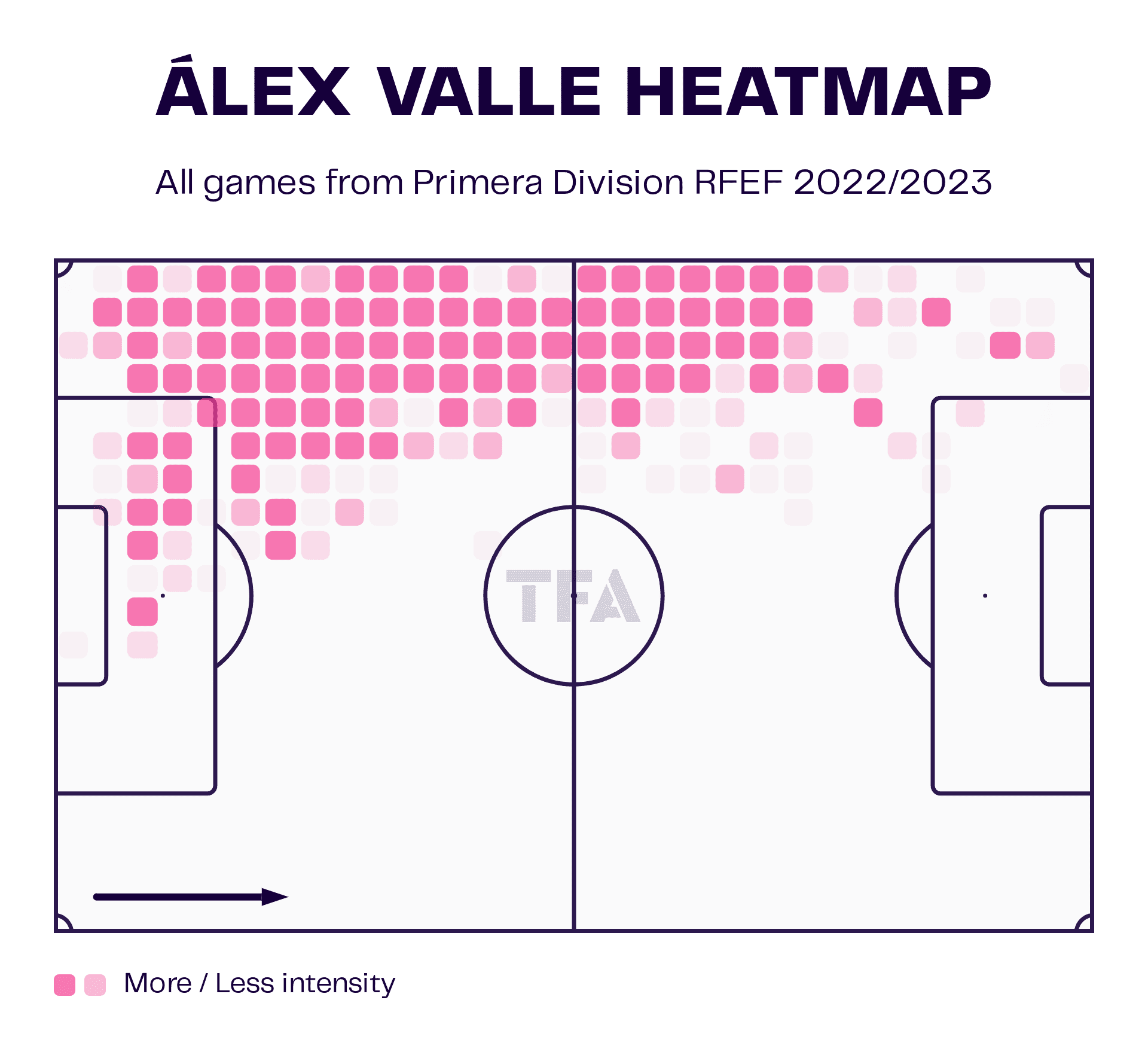
We can see from Valle’s heatmap that he is a very attack-minded left-back who prefers to stay wide, allowing him to create an additional attacking option for the team.
He is able to stretch the opposition’s defence horizontally, which creates more space for his teammates to operate in central areas.
This positioning allows Valle to receive passes in advanced positions, make overlapping runs, and contribute to the team’s attacking play.
This widens the field and stretches the opposition’s defence, creating gaps and openings that the team’s attackers can exploit.
Valle’s positioning also enables the team to create overloads on the left flank, as he can combine with the left winger or left-sided central midfielder to outnumber the opposition in that area.
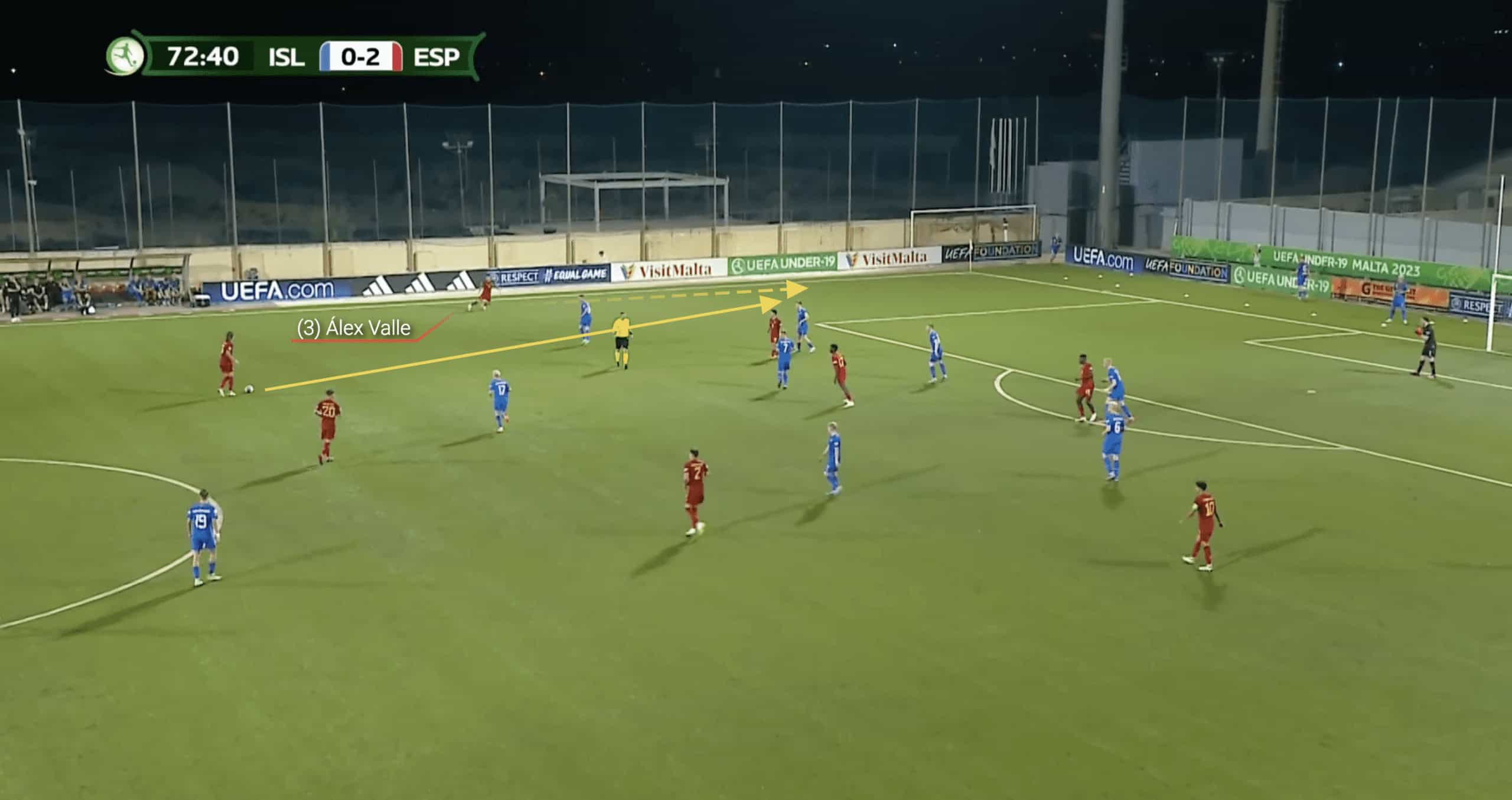
Here in figure 6.1, we can see that Valle is positioned wide on the left, virtually on the touchline.
This allows him to stretch the play, which draws defenders out wide and will enable teammates to operate effectively in central areas.
Additionally, it means that Valle has a better vantage point to deliver accurate crosses into the opposition’s penalty area.
His positioning allows him to have a clear line of sight and more time to pick out teammates with precise crosses.
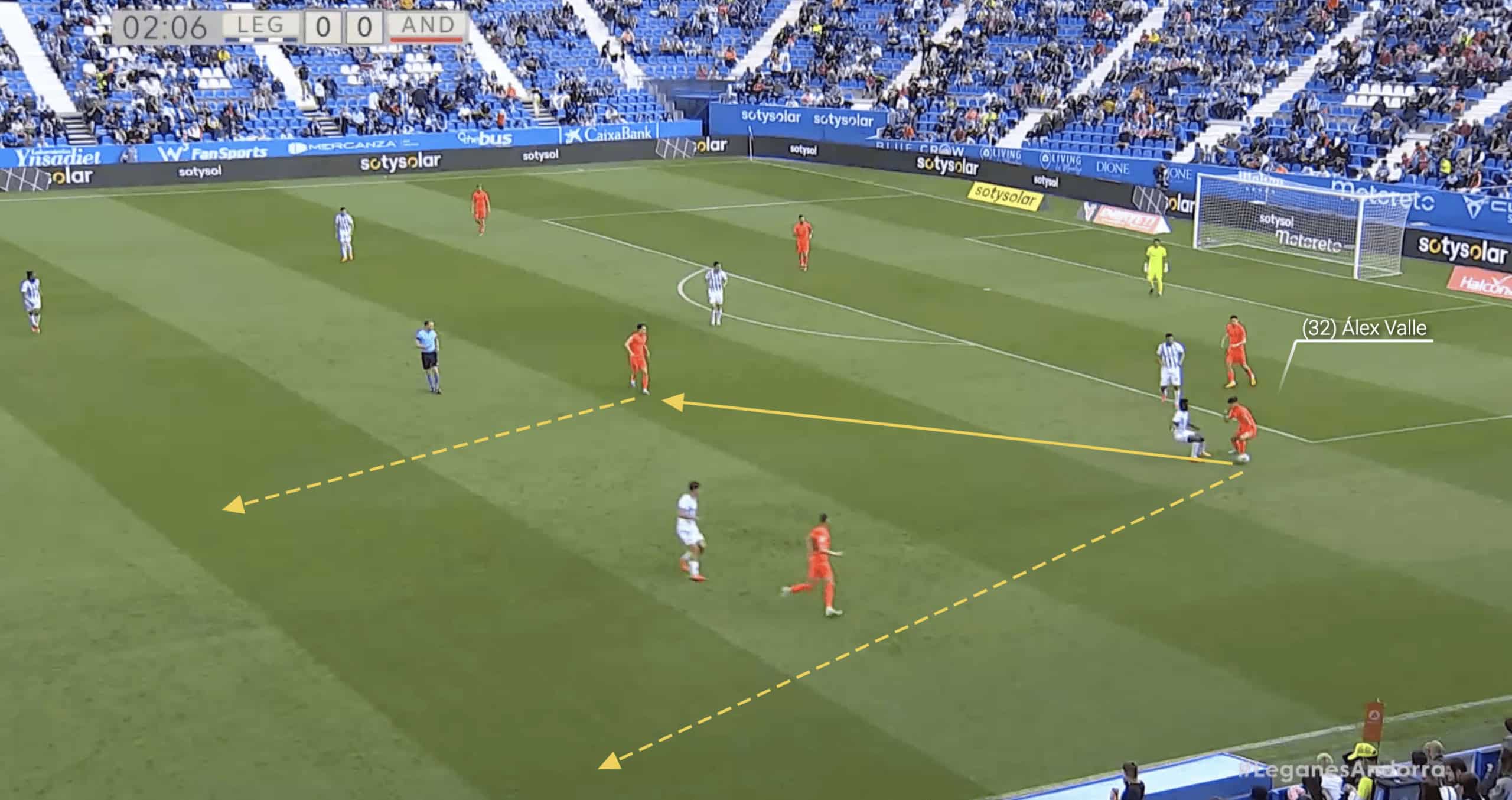

Valle possesses excellent link-up play and off-the-ball movement.
Here in figure 6.2, we can see he is able to evade the opposition press by playing an intelligent pass to a teammate.
Upon releasing the ball, Valle then makes a forward run in order to kick-start the attack.
A few seconds later, as shown in figure 6.3, the attacker lays the ball back to the midfielder while Valle exploits the space by making a run in behind the opposition’s defensive line.
Additionally, the left-back’s excellent off-the-ball movement can be instrumental in creating overloads in the attacking third.
By making well-timed forward runs into space, he can attract the attention of the opposition’s defenders.
This opens up additional space for teammates, allowing the team to overload the attacking area and create numerical advantages that can lead to increased goal-scoring opportunities.
Álex Valle Progressive Passes Map
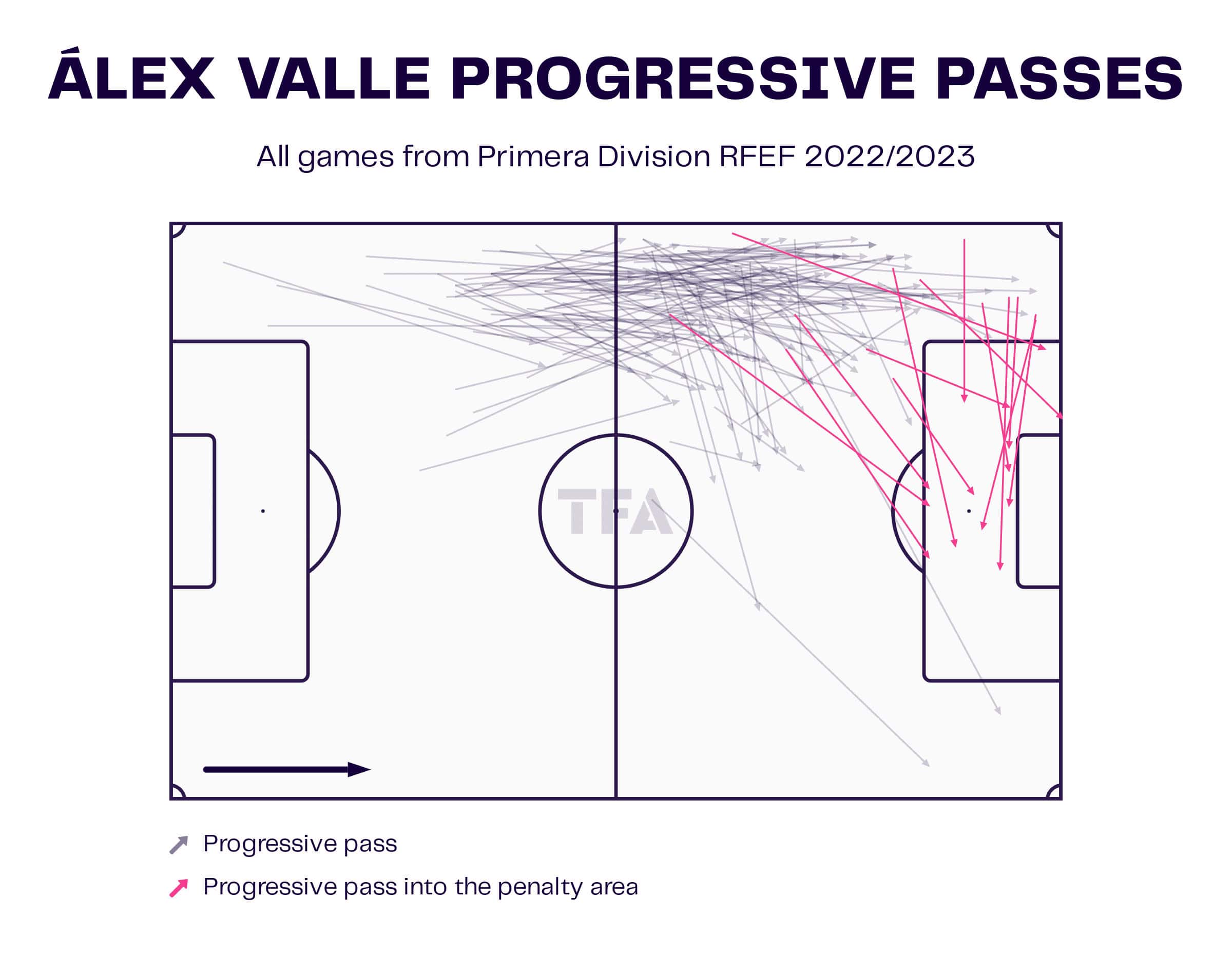
The data visual above illustrates Valle’s progressive passes during his tenure at Adorra.
It becomes evident that the defender actively contributed to advancing the play in the left half space and down the flank.
A significant portion of his progressive passes were directed towards these areas, indicating his proficiency in exploiting these channels to drive the team’s attack forward.
Moreover, Valle’s ability to connect with the attackers is noteworthy as he demonstrated the skill to link up effectively with his teammates, allowing the team to create through his progressive passes into the box.

Here in figure 6.4, we can see Valle playing a pass over the top as the attacker looks to make a run in behind the opposition’s defensive line.
As shown above, the Spain left-back possesses an excellent passing range that allows him to catch the opponent off guard by playing accurate long passes over the top.
This allows Álex Valle to play a significant role in his team’s offensive strategies and contribute to their overall goal-scoring potential.
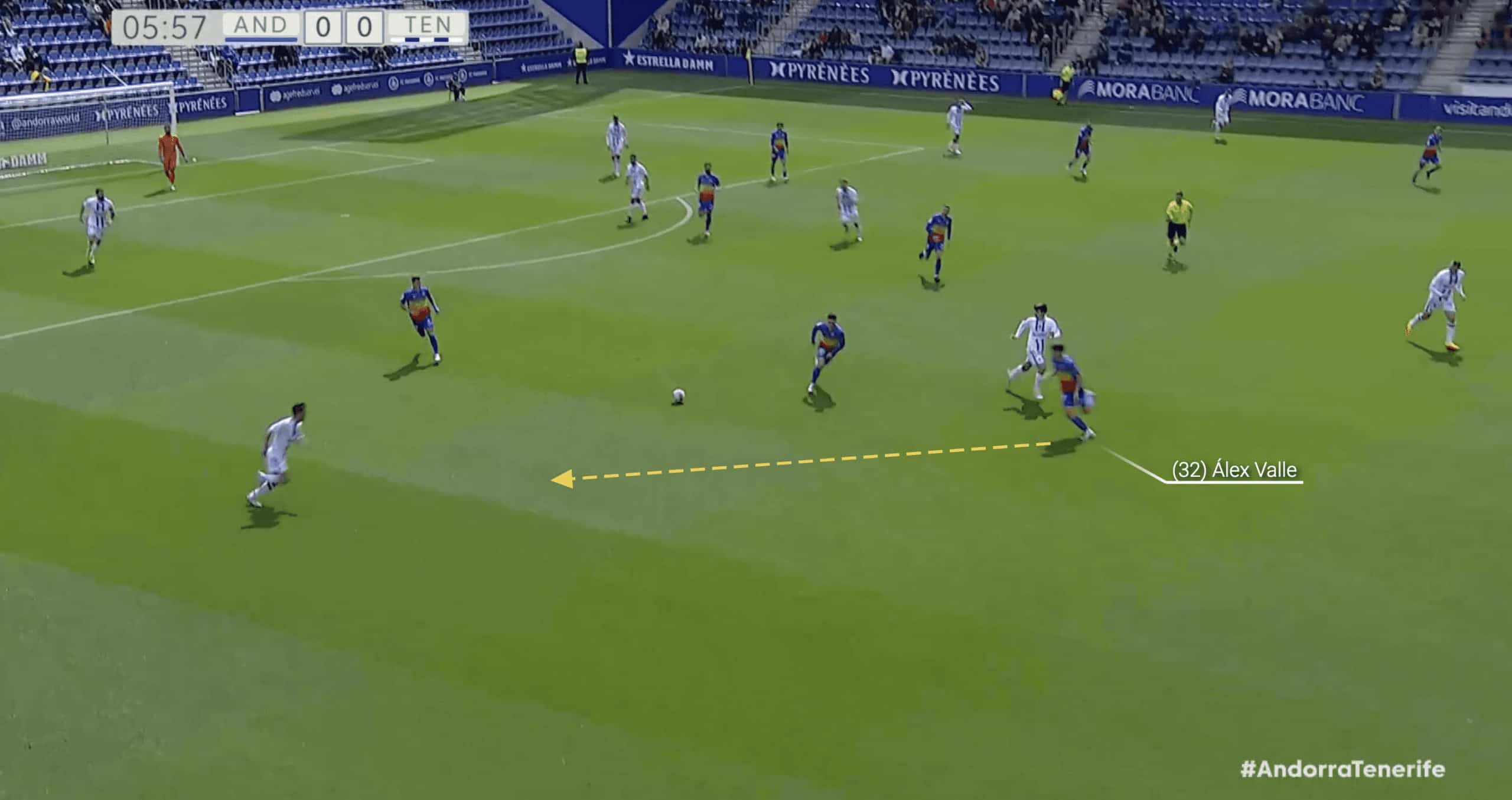
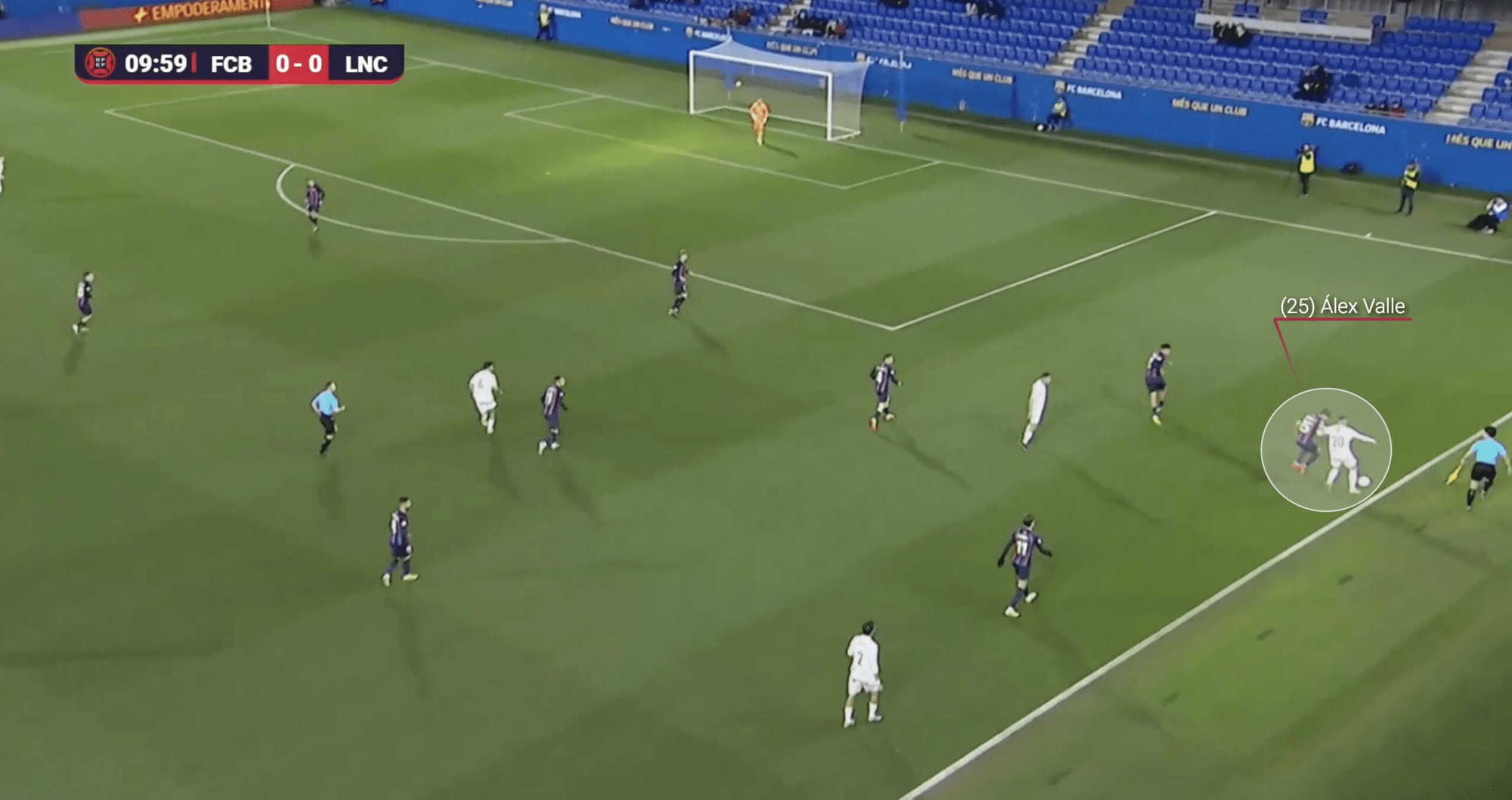
When analysing Álex Valle’s defensive abilities, it becomes apparent that he consistently demonstrates intelligent decision-making.
In Figure 6.5, for instance, after Andorra lose possession, Valle proactively chooses to close down the opposing player swiftly.
This quick reaction prevents the opponent from gaining control of the ball, effectively allowing Andorra to regain possession and maintain defensive stability.
Figure 6.6 showcases Valle’s astuteness in a 1v1 situation with an opponent.
Rather than resorting to sliding tackles or committing a foul, he engages his upper body strength and utilises his body orientation effectively.
By doing so, he prevents the attacker from successfully dribbling past him and eliminates the potential for an opening to generate a dangerous cross.
Thanks to Valle’s intelligent defensive approach ensures that the opponent’s attacking threat is nullified.
Valle’s defensive contributions exemplify his active decision-making and situational awareness.
By making smart choices, he consistently disrupts opposing attacks, minimises scoring opportunities, and contributes to Andorra and Barcelona B’s defensive solidity.
His ability to read the game, react quickly, and utilise his physical attributes effectively showcases his value as a reliable and intelligent defender for the team.
Conclusion
To conclude, in this scout report, we have highlighted six players worth keeping an eye on at Euro U19, but truthfully all the teams are stacked with a wealth of talented young players, many of whom will go on to make a name for themselves.
Euro U19 has an incredible amount of talented players taking part, and many clubs will be scouting players as they look to sign Europe’s most sought-after players for the future.





Comments